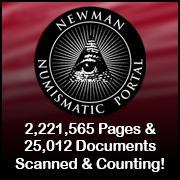
About UsThe Numismatic Bibliomania Society is a non-profit association devoted to the study and enjoyment of numismatic literature. For more information please see our web site at coinbooks.org SubscriptionsThose wishing to become new E-Sylum subscribers (or wishing to Unsubscribe) can go to the following web page link MembershipThere is a membership application available on the web site Membership Application To join, print the application and return it with your check to the address printed on the application. Print/Digital membership is $40 to addresses in the U.S., and $60 elsewhere. A digital-only membership is available for $25. For those without web access, write to: Terry White, Treasurer AsylumFor Asylum mailing address changes and other membership questions, contact Terry at this email address: terrywhite5475@yahoo.com SubmissionsTo submit items for publication in The E-Sylum, write to the Editor at this address: whomren@gmail.com BUY THE BOOK BEFORE THE COINSale Calendar |
- WAYNE'S WORDS: THE E-SYLUM OCTOBER 28, 2018
- NEW BOOK: ERRORS AND VARIETIES ON CANADIAN COINS
- NEW BOOK: JEWISH-AMERICAN HALL OF FAME MEDALS
- HAPPY 80TH BIRTHDAY Q. DAVID BOWERS
- WHAT'S NEXT AT THE NEWMAN NUMISMATIC PORTAL
- NOTES ON THE DEARLY DEPARTED
- NOTES FROM E-SYLUM READERS: OCTOBER 28, 2018
- MORE ON RISLEY & MCCOLLUM'S HIPPODROME TOKEN
- VOCABULARY TERMS: ALLEGORY AND PERSONIFICATION
- CHARLES DIETRICH REIMERS (1872-1946)
- SPENDING AN OLD $10 BILL: GOOD DEED GONE BAD
- 2018 U.S MINT FORUM REPORTS
- THE 1787 BRASHER DOUBLOON ELECTROTYPE
- CIVIL WAR REDENOMINATED U.S. COINAGE
- NUMISMATIC NUGGETS: OCTOBER 28, 2018
- NEWMAN SALE X CURRENCY HIGHLIGHTS
- NEWMAN SALE XI VOLUME 1 COIN HIGHLIGHTS
- NEWMAN SALE XI VOLUME 2 LITERATURE HIGHLIGHTS
- MOUNTING COINS FOR MUSEUM EXHIBITS
- GEYSER SPEWS SHOWER OF OLD COINS
- ROYAL CANADIAN MINT TEST TOKENS
- 1912 SUFFRAGETTE HUNGER STRIKE MEDAL
- AUSTRALIAN MILITARY DOG AWARDED DICKIN MEDAL
- MSU MUSEUM COLLECTION REDISCOVERED
- NEW ZEALAND VEGANS PROTEST POLYMER BANKNOTES
- WHIO: THE BLUE DUCK ON NEW ZEALND BANKNOTES
- LOOSE CHANGE: OCTOBER 28, 2018
- BIKINI COINGIRL
Click here to access the complete archive a
Click here to unsubscribe (scroll down)
To comment or submit articles, reply to whomren@gmail.com
Content presented in The E-Sylum is not necessarily researched or independently fact-checked, and views expressed do not necessarily represent those of the Numismatic Bibliomania Society.
WAYNE'S WORDS: THE E-SYLUM OCTOBER 28, 2018
 New subscribers this week include: Carmen Notoris, courtesy of Jeff Zarit; Paul Hill, and Charles Savelle. Welcome aboard! We now have 5,779 subscribers.
New subscribers this week include: Carmen Notoris, courtesy of Jeff Zarit; Paul Hill, and Charles Savelle. Welcome aboard! We now have 5,779 subscribers.
Thank you for reading The E-Sylum. If you enjoy it, please send me the email addresses of friends you think may enjoy it as well and I'll send them a subscription (but let me know if they are located in the European Union). Contact me at whomren@gmail.com anytime regarding your subscription, or questions, comments or suggestions about our content.
This week we open with two new books, a birthday, an update on the Newman Numismatic Portal, and reader notes on our recently departed numismatists.
Other topics this week include allegory and personification in numismatics, the 2018 U.S. Mint Forum, a Brasher Doubloon electrotype, redenominated U.S. coinage, Newman sale highlights, Royal Canadian Mint test tokens, a suffragette hunger strike medal, and New Zealand banknotes.
To learn more about Canadian error coins, Holland Wallace, Risley & McCollum's Hippodrome token, bios durci, black widow spiders, Washington Getz patterns, a new Dickin medal recipient, Bikini Coingirl, and the spooky Birch cent, read on. Have a great week, everyone!
Wayne Homren
Editor, The E-Sylum
NEW BOOK: ERRORS AND VARIETIES ON CANADIAN COINS
Canadian numismatic literature dealer Richard Stockley forwarded this announcement of a new book on Canadian coin errors & varieties. Thank you. -Editor
 The first in a new series of books on Canadian error coins of the Elizabeth II era is scheduled for release this November.
The first in a new series of books on Canadian error coins of the Elizabeth II era is scheduled for release this November.
Volume 1,in color will be on the one cent pieces. It will contain 274 pages with over 1500 listings. It will be in French & English.
Printing will be limited to about 200 copies.
Price is listed at $65 but is available now at $55 CAD + post.
Vol 2 on 5 cents is scheduled for autumn 2019
Vol 3 for autumn 2020
To reserve your copy, please email me at rstockley@videotron.ca
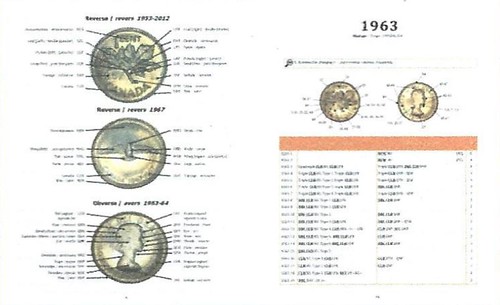


NEW BOOK: JEWISH-AMERICAN HALL OF FAME MEDALS
Project Coordinator Len Augsburger provided the following press release. Thanks. -Editor
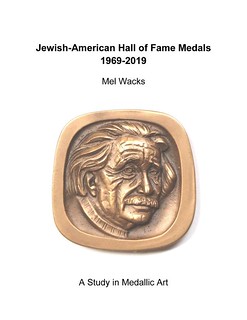 Medal collectors, American history buffs and those interested in Judaica can now read Jewish-American Hall of Fame Medals 1969-2019 by Mel Wacks, newly published
on the Newman Numismatic Portal at https://nnp.wustl.edu/library/book/556056. Mel is uniquely qualified to write this
compendium of what currently is the longest continuing series of art medals in America, since he initiated the project and has overseen it for its 50 year history.
Medal collectors, American history buffs and those interested in Judaica can now read Jewish-American Hall of Fame Medals 1969-2019 by Mel Wacks, newly published
on the Newman Numismatic Portal at https://nnp.wustl.edu/library/book/556056. Mel is uniquely qualified to write this
compendium of what currently is the longest continuing series of art medals in America, since he initiated the project and has overseen it for its 50 year history.
Mel says in the Introduction, “The goal [of the Jewish-American Hall of Fame medals] was not only to raise funds for the Magnes Museum, but to raise awareness in Jews and non-Jews alike in the substantial contributions made to America—and the world—by American Jews.” The project was under the auspices of the Judah L. Magnes Museum in Berkeley from 1969 through 2001, when it became a division of the American Jewish Historical Society in New York. The sale of the medals has raised nearly a quarter of a million dollars for these two educational organizations, along with the American Numismatic Society, and other non-profits.
The new book features biographies of more than 50 Jewish-American Hall of Fame inductees, taken from their web site www.amuseum.org/jahf; back stories about the creation of the medal designs; medal specifications (size, mintages and mints); and short biographies of the more than dozen medalists and calligraphers who created the medals. In addition, there are two appendices—one describing the Wooden Shekels issued by the Jewish-American Hall of Fame intermittently from 1968-2009, and the other listing, for the first time, all 35 Special Commemorative Medals Issued by the Jewish-American Hall of Fame--from the counterstamped Camp David Peace Dollar in 1978 through the Emma Lazarus Statue of Liberty Award (for the American Jewish Historical Society) in 2018.
Jewish-American Hall of Fame Medals 1969-2019 is an indispensable guide to a series that offers collectors a real challenge. As Mel Wacks concludes in the Preface: “It is not easy [to assemble a complete collection], since mintages are very low—as few as 100 bronze, 55 pure silver, and a minuscule 11 gold. Remember—the fun is in the hunt!” And the fun is also in reading this book, offered free to all on the Newman Numismatic Portal.
To learn more about the Jewish-American Hall of Fame, visit
http://www.amuseum.org/jahf.
HAPPY 80TH BIRTHDAY Q. DAVID BOWERS
Happy Birthday to author/researcher/dealer Dave Bowers, who turns 80 this week! These photos were published in the October 27, 2018 Stack’s Bowers Galleries E–Newsletter (Vol. 7, No. 43). -Editor
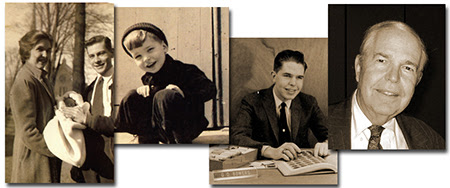
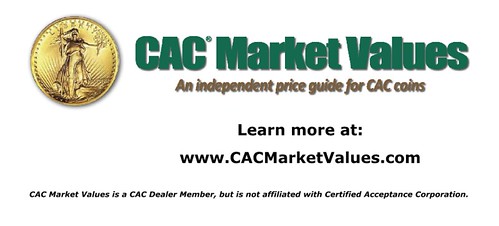
WHAT'S NEXT AT THE NEWMAN NUMISMATIC PORTAL
Last week I was so busy working on E-Sylum obituaries that I forgot to announce that I would be speaking about the Newman Portal at the Whitman Baltimore Expo. To get the word out, we improvised. First, Len Augsburger published an announcement to the NNP email list and Facebook account. Then I sent it out by email to friends and readers I thought might be attending the show. Several sent regrets, but there were also enough positive responses that I no longer feared speaking to an empty room. Here's the announcement. -Editor
Newman Numismatic Portal Goes on the Road
Wayne Homren, Newman Numismatic Portal consultant, will be speaking at the Whitman Baltimore Expo on Friday, October 26, at 1pm in room 301 of the Baltimore Convention Center. Come and hear about the latest Newman Portal content updates and future direction. See you there!
Some of those unable to attend (including Yale Lansky, Peter Bertram, Robert Hoge and others) asked if information on my talk would be available online, so below is a summary. We had a nice turnout. Attendees included Len Augsburger, Bill Bugert, Bill Eckberg, David Gladfelter, Maureen Levine, Roger Siboni, Alan Weinberg and Garrett Ziss. Dennis Fortier of the Liberty Seated Collectors Club (LSCC) filmed a video that hopefully we can post at a later date. -Editor
I opened with a few slides giving an overview of the Newman Numismatic portal, including our founder Eric Newman's vision and the organization structure, including Washington University in St. Louis, the Internet Archive, and consultants including myself and the software developers.
Audiences enjoy learning about the mechanics of digitization. I explained that despite numerous attempts no one has yet developed a robot that does a better job than humans at turning pages without mishaps. So the scanning of printed books and other materials is human-powered, with a librarian or student at the controls of a custom-built scanner with an angled cradle that takes high-resolution images of both left and right-hand pages simultaneously. Designed for the Internet Archive, it has integrated software that uploads images to the web where post-processing is done, including optical character recognition (OCR). Here's student Kevin Ha at work.
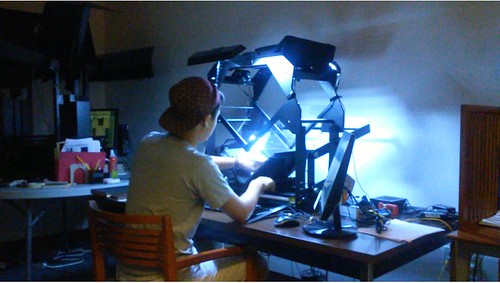
Next I reviewed the major content types - Books, Periodicals, Auction Catalogs, Images and Archival Material, illustrating each with a selection of images. Here are some selected periodicals.
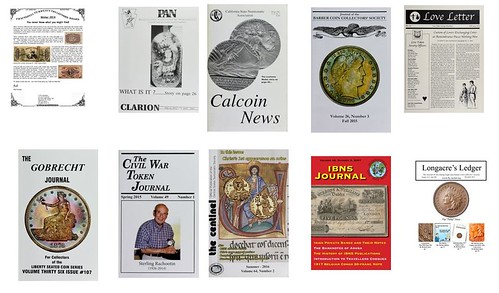
While discussing periodicals I touched on one of the upcoming features we're working on. Now that there is so much material in the portal we want to provide more useful ways to organize and discover it. To better organize the periodical section, we're adding tags to classify them by type - commercial publications, club journals, dealer house organs, fixed price lists, etc. Here's some of the sausage-making in action - I'm adding a periodical type column to a spreadsheet.
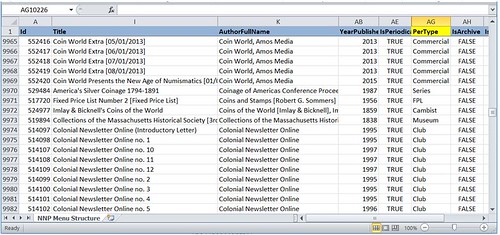
Other new initiatives include the creation of image collections for the Newman colonial paper money collection, a new online edition of Newman's The Early Paper Money of American book, "Advanced Search" and "Power Search" features. Further out on the horizon are personalization features like favorites lists, user collections and tagging, plus a numismatic web site archive.
We concluded with a question and answer session addressing both site content and user features, including desired search features.
Many thanks to John Frost of LSCC and the Barber Coin Collector's Society for lending us the projector and extension cord!
To see the complete presentation slide deck, see:
Newman Numismatic Portal Presentation (https://nnp.wustl.edu/library/book/556614)
To visit the Newman Numismatic Portal, see:
https://nnp.wustl.edu/
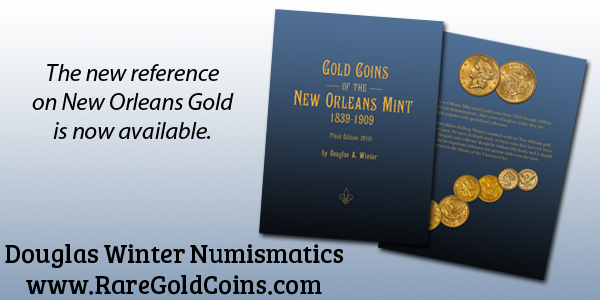
NOTES ON THE DEARLY DEPARTED
Last week was a record for E-Sylum obituaries (five), and I hope that record stands for a long time. It made for a hectic weekend, with emails flying constantly. But the issue somehow came together, and I was happy to be able to assemble tributes to our old friends. Here are some additional reader comments. -Editor
Vic Mason of Mamaroneck, NY writes:
I’m sorry to hear about the recent passing of the five distinguished ANA members. They represented a lot of collective numismatic wisdom. I have long enjoyed The Cherrypickers’ Guide of J.T. Stanton and Bill Fivaz.
Frank Robinson writes:
Wow! Holland Wallace, J.T. Stanton, Cal Wilson, and more. Seems like a numismatic holocaust. I feel lucky to still be here.
Me, too! I felt like the Grim Reaper last week. When the shock wore off I wondered if there was any humor we could salvage from the situation. I knew three of the five (Cal, Del and J.T) and think they'd appreciate the irony. So what what it would be like if three numismatists showed up together at the Gates of Heaven? Would Saint Peter have a test for them? Maybe, "attribute this coin and you can enter!"
I could see Del Bland going first, beaming when he saw a U.S. Large Cent in the apostle's hand. "That the best ya got, Pete? That's easy - a Sheldon-32" Peter waves him through the gate.
Next is Cal Wilson and Saint Peter pulls out another Large Cent. Cal reaches into a bag and brings out a copy of Penny Whimsy. He looks at the coin, flips through several pages, then pronounces it a Sheldon-45. Peter waves him through the gate.
Now J.T. is up. Out comes another Large Cent. J.T. frowns, but notices Cal left his book behind. He picks it up, flips thru the pages while checking the coin. He pulls out a high-power magnifier and scrutinizes the coin He looks again at the book, then the coin. "What is this - a trick question?" he asks. It's a new variety. It's like Sheldon 65, but the last '0" in '100' has been recut. Peter smiles and waves J.T. through.
Then Del pipes in, his head towering over the top of the gate. "Who owns that piece? Where did they get it? And can you send me down to New York for a couple hours? I gotta update my binders." -Editor
Holland Wallace
Brian R. Stickney writes:
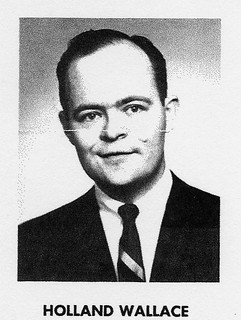 I was saddened to hear of the passing of Holland Wallace. Oddly, in all the years of collecting Latin American coinage and writing about Central America, I don't
ever remember actually meeting Holland, in part, because much of my foreign service career was spent overseas. But, though quiet and unassuming, Holland's positive influence
was omnipresent. In my view, Holland authored and published one of the more influential numismatic works of the modern era, Central American Coinage Since 1821, published
in 1965 and 1966 from Weslaco, Texas. This handy 125-page book opened the field to collecting the seven countries now constituting Central America.
I was saddened to hear of the passing of Holland Wallace. Oddly, in all the years of collecting Latin American coinage and writing about Central America, I don't
ever remember actually meeting Holland, in part, because much of my foreign service career was spent overseas. But, though quiet and unassuming, Holland's positive influence
was omnipresent. In my view, Holland authored and published one of the more influential numismatic works of the modern era, Central American Coinage Since 1821, published
in 1965 and 1966 from Weslaco, Texas. This handy 125-page book opened the field to collecting the seven countries now constituting Central America.
Holland's work provided just enough background to arouse interest and provide historical context but, then, saturated the reader with numismatic detail not really seen in references to that date. Central American Coinage incorporated a plethora of photos along with each coin's narrative description, weight, diameter, and metallic content along with prices in three-to-four grades and the occasional cryptic comment on rarity or variations. Also, for the first time, he provided extensive mintage data, where known. He set the tone for future endeavors addressing country, regional, and even global numismatic references works. He will be missed.
Cal Wilson
Dave Lange writes:
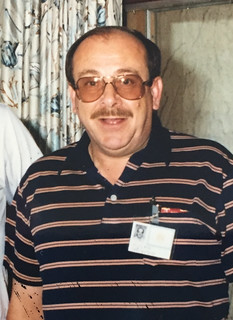 I knew Cal Wilson well all through the 1980s and up until the time I left California for New Jersey in 1994. When I first became serious about numismatics as being more
than just filling holes in an album, I began to seek reference books in the United States field. This was in the late 1970s, and very few new books of any merit were being
published, but Al Hoch's Quarterman Publishing was making evermore reprints available of the great early works.
I knew Cal Wilson well all through the 1980s and up until the time I left California for New Jersey in 1994. When I first became serious about numismatics as being more
than just filling holes in an album, I began to seek reference books in the United States field. This was in the late 1970s, and very few new books of any merit were being
published, but Al Hoch's Quarterman Publishing was making evermore reprints available of the great early works.
I met Cal at the Fremont (California) Coin Club's annual show around 1980 or so, and he was just then beginning to dabble in selling numismatic literature. I ended up buying the Quarterman edition of Valentine's book on half dimes out of the trunk of his car right then and there. He mentioned that he could supply other desired books, such as Crosby, Newcomb and Browning, but he didn't have them with him. Instead, we arranged to meet another day in the parking at the canning company where he worked in some executive capacity. He popped the trunk, and voila! I thus acquired several more books in this manner, until Cal mentioned that he was actually opening up a numismatic literature business. It was around that same time that he convinced me to the join the NBS.
Cal initially had an actual store front in Fremont, but the overhead of this must have been too much, because he soon relocated to what could only be described as a "unit" in a light industry building. It may have been an actual storage facility, but I was so preoccupied with finding his door that he didn't take much notice. I made a point of visiting him at least one Saturday each month, and many times I didn't buy a thing. We just shared some gossip and made plans for get-togethers with other numismatic "bookies" at coin shows and conventions. It was always an enjoyable experience, but I did learn that Cal's mood was quite variable. There were times when he seemed rather melancholy and drank one or two beers too many, but it never affected our friendship. I was a charter subscriber to Wilson's Numismatic Repository and even submitted artwork for its masthead, though Cal wisely selected a better entry for his publication.
In the early '90s he began having actual numismatic literature auctions in conjunction with coin shows in Santa Clara and San Jose, but these seemed to overwhelm him a bit. There were more and more piles of stuff that people had sent him that just weren't practical to sell and ship. One incident I remember well was when he received a complete run of Coin World from a consignor in the Southwest. When he began opening the cartons, dozens of black widow spiders scattered in all directions. He ended up dumping the entire lot and simply paying the consignor his shipping cost to be done with it. These kinds of stories were becoming more commonplace, and I could see that he wasn't enjoying the business anymore. Cal folded up shop, and I saw him only sporadically after that. I later heard stories about unpaid consignors and similarly distressing issues, though I can say that all my transactions with Cal were rewarding ones. I'm sorry to learn of his passing.
Del Bland
Dave Lange writes:
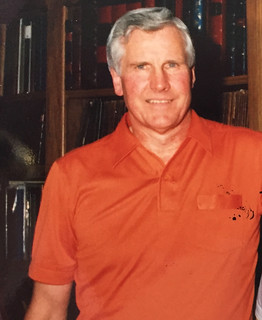 I didn't know Del Bland beyond a casual acquaintance, and that was mostly in the mid 1980s. I met him through my then girlfriend Carol, who was an enthusiast of 1794
cents, and Del was her mentor. I was always impressed with his vast knowledge and gentlemanly manner, and I could see that he was an excellent counselor to Carol. Del understood
her very limited budget and did what he could to steer bargains her way. He provided an excellent counterpoint to anyone who claimed that the EAC bigwigs were sometimes dismissive
of beginners. I've never found that to be true, and Del was a superb ambassador for both the hobby and the EAC.
I didn't know Del Bland beyond a casual acquaintance, and that was mostly in the mid 1980s. I met him through my then girlfriend Carol, who was an enthusiast of 1794
cents, and Del was her mentor. I was always impressed with his vast knowledge and gentlemanly manner, and I could see that he was an excellent counselor to Carol. Del understood
her very limited budget and did what he could to steer bargains her way. He provided an excellent counterpoint to anyone who claimed that the EAC bigwigs were sometimes dismissive
of beginners. I've never found that to be true, and Del was a superb ambassador for both the hobby and the EAC.
George Kolbe writes:
I first met Del in the mid-1970s. He was the first person interested in numismatic literature to visit me in Mission Viejo. This was before my first auction in early 1976 and, truth be told, well before it occurred to me that there was a living to be made selling rare and out of print numismatic publications. Del certainly encouraged me on that visit, the first of many to come (Linda and I marveled at the hundred dollar bills he left in exchange for paper-covered pamphlets). Del was literally a Parnassus on Wheels, though he was more interested in buying than in selling and his main focus was on United States large cents—perhaps only somewhat more than the body of literature supporting them.
Over the following years, Del visited me at home in Mission Viejo, at my first office in Santa Ana, then back to Mission Viejo in a 1,100 square foot facility in a nearby business center. In 1983, we moved to Crestline where, after a large addition, the entire first floor of our new home was devoted to the business, and a large adjoining garage served as a storage area for incoming shipments. It almost goes without saying that Linda and I were rarely able to park our cars in said garage, though there was substantial additional storage space therein, along with well over 1,000 linear feet of shelves and additional storage space inside the office.
During his frequent visits to Crestline, Linda and I spent many pleasant hours with Del. Sometimes he was accompanied by Bob Vail, an accomplished bibliophile; in later years Jan Valentine sometimes completed the dance card. John Bergman often drove up and all of us would routinely go out to dinner at The Stockade, a bar/restaurant with a dubious facade but great food.
It was a wonderful time, and Del’s friendship and encouragement was a lodestar to Linda and me. He was a very good bargainer but the process was always friendly end enjoyable. Del must have purchased thousands and thousands of classic American auction sale catalogues, ranging in value from a dollar or two to four figures. This immense body of data, heavily supplemented by other sources, enabled Del to substantiate the malfeasance of Dr. Sheldon and, even more importantly, to establish pedigree chains for virtually every significant large cent depicted anywhere in the literature. This was done in the days when snail mail was the only mail, and personal computers were virtually non-existent.
If one were to ask advanced American coin collectors about Del Bland, many of those whose acquisitional compass does not include large cents or numismatic literature would not know of him. Those of us who were privileged to know Del, know that he was a numismatic giant. There will never be another like him.
Thanks, everyone. -Editor
To read the earlier E-Sylum articles, see:
CAL WILSON (1944-2018) (http://www.coinbooks.org/v21/esylum_v21n42a11.html)
DEL BLAND (1933-2018) (http://www.coinbooks.org/v21/esylum_v21n42a13.html)
HOLLAND WALLACE (1940-2018) (http://www.coinbooks.org/v21/esylum_v21n42a14.html)
STEVE RATLIFF (1947-2018) (http://www.coinbooks.org/v21/esylum_v21n42a15.html)
J.T. STANTON (1952-2018) (http://www.coinbooks.org/v21/esylum_v21n42a16.html)

NOTES FROM E-SYLUM READERS: OCTOBER 28, 2018
Coppola's Directors Guild of America Medal
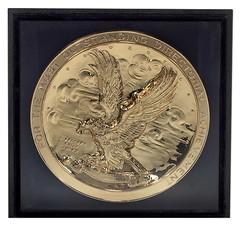 Michael Wehner of San Francisco writes:
Michael Wehner of San Francisco writes:
I don't know who designed this medal. But I do know where you can see one. Francis Ford Coppola has his displayed, along with numerous Oscar statuettes and other awards, at the museum in his winery in Geyersville, California. It is indeed an impressive piece. Food and wine are good there, too...
Thanks. Check it out if you're in the area. -Editor
To read the earlier E-Sylum article, see:
NUMISMATIC NUGGETS: OCTOBER 21, 2018 : Directors Guild of America Medal
(http://www.coinbooks.org/v21/esylum_v21n42a29.html)
Inscribed Numismatic Books
Dave Hirt writes:
Regarding books dedicated and/or autographed by the author - In some categories of books these are highly prized by collectors, and sell much higher than plain editions. However, with numismatic books this does not seem to be appreciated. I have bought dedicated numismatic books with that fact not even mentioned in the seller's description. Do our readers have any ideas why this is?
Well, I'll be interested to see what readers have to say. Some numismatic literature cataloguers certainly do mention inscriptions. These are books I like to collect as well - one copy of a book is the same as any other, but an inscription makes it unique. -Editor
Video: Jewish-American Hall of Fame Medals
Skyler Liechty of the Medal Collectors of America (MCA) sent this link to a video of the talk given to the group by Mel Wacks at the ANA World's Fair of Money in Philadelphia this past summer. -Editor
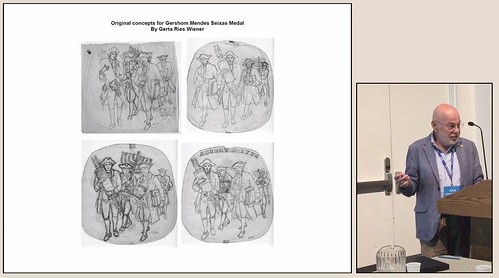
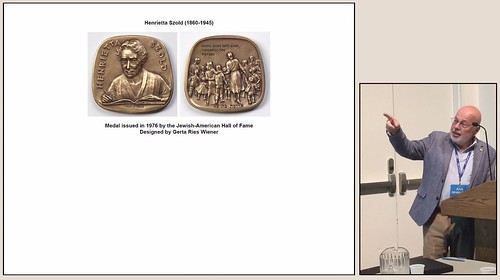
Mel Wacks presents medals created by Victor Ries and Gerta Ries Wiener between 1969-1994. Keynote given to the Medal Collectors of America August 2017 at the ANA World's Fair of Money.
Skyler adds:
The talk was summer 2017. We are behind trying to get videos edited. Luckily Joe Marino our webmaster has stepped up to take that task off my plate.
To watch the complete video, see:
Jewish-American Hall of Fame Medals Lecture by Mel Wacks
(https://www.medalcollectors.org/multimedia/video/victor-gerta-ries)
Correction: Purple Heart Medal Not Kennedy's
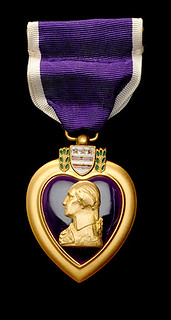 In last week's article about the American Numismatic Association's exhibit of a Kennedy collection, an image of a Purple Heart medal was labeled (in part):
In last week's article about the American Numismatic Association's exhibit of a Kennedy collection, an image of a Purple Heart medal was labeled (in part):
"Kennedy was awarded this medal and many others for heroism as commander of Patrol Torpedo Boat 109."
I wrote:
But this one knocked my socks off - Kennedy's Purple Heart! Wow - how did that come to rest at the Edward C. Rochette Money Museum?
Robert Hoge writes:
I noticed your amazement regarding the Purple Heart medal in the ANA Museum attributed to President Kennedy. In fact, I believe the label for that piece (which you showed) was quite misleading; if it really had been the actual medal awarded to Kennedy, you could be sure that the ANA would have made much mention of this fact. Although I have not verified this, I very much doubt it is his own personal medal.
Andy Dickes of the ANA writes:
Thanks for featuring the Kennedy page I put together. I need to clarify that the Purple Heart featured is not Kennedy's, just an example of the award. I will adjust the text to make that more clear.
Thanks. That makes more sense. I assume Kennedy's medal is either with his family or resting at the Kennedy Presidential Library. -Editor
To read the earlier E-Sylum article, see:
THE ANA JOHN F. KENNEDY COLLECTION (http://www.coinbooks.org/v21/esylum_v21n42a33.html)
Spooky 1792 Birch Cent
 Pete Smith writes:
Pete Smith writes:
A new 1792 Birch Cent has appeared on the market. One story is that it was found by a metal detector in a Massachusetts cemetery near Salem. According to this story, acidic conditions in the soil caused corrosion on the obverse leading to the unusual appearance.
I am skeptical of this story but don’t have a better one to offer. Whatever the explanation, I think the coin makes a good lead-up to Halloween.
Miss Liberty certainly is in a fright, but she's kept her smile. Thanks, Pete. -Editor
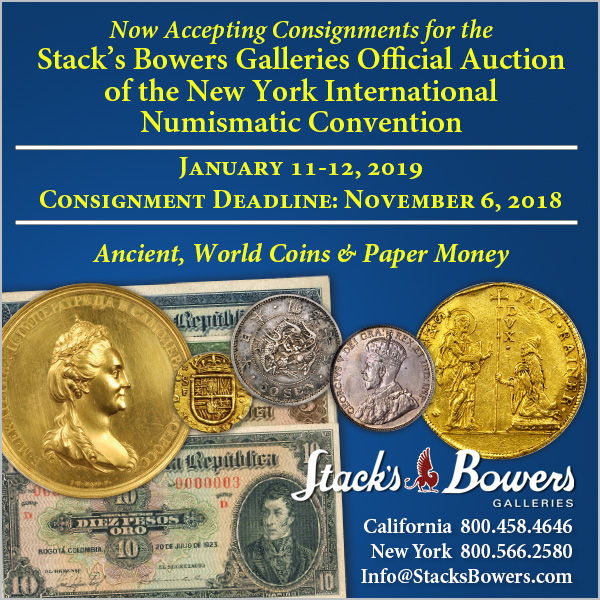
MORE ON RISLEY & MCCOLLUM'S HIPPODROME TOKEN
In a May 2017 Numismatic Nuggets column I selected a scarce circus token offered in a Stack's Bowers sale. Here's the lot description. -Editor
Risley & McCollum's Hippodrome Token
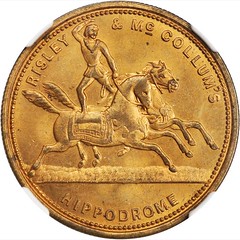
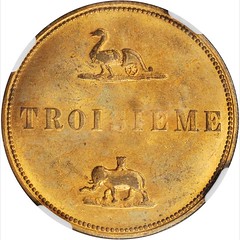
New York--New York. (Circa 1850s) Risley & McCollum's Hippodrome. Miller-NY 663 (type). Gilt brass. 33 mm. MS-63 (NGC).
TROISIEME reverse. 80% or more of the original gilding survives, with wisps of olive-green on the high points and a dusting of blue on the reverse. A classic early American circus token, described as "extremely rare" by Satterlee in 1862.
Provenance: Ex F.C.C. Boyd; our (Stack's Bowers) sale of the John J. Ford, Jr. Collection, Part XXIII, lot 22516. Lot tag and paper envelope with attribution notation included.
Margaret Kirby found the item on the web; below is an excerpt from the note she submitted to me. Thank you! -Editor
I am researching circus in the mid-nineteenth century and I am thrilled to find your coins picturing Thomas McCollum at the Hippodrome.
I think that the coin commemorates a circus co-run briefly by McCollum and Risley in 1852 in England.
Thomas McCollum (1928-1872) was an American two horse rider and was admired by some of the most famous riders of his day, including James “Yankee” Robinson.
He is first mentioned in American circus bills in 1837 and was taught by a rider called Matthew Buckley, but also in the same company was John Robinson, famous for producing exceptional student riders, including James. He had his own company called Stone and McCollum’s Great Western Circus between 1846 and 1850. He was 18 when this partnership began. The first year they traveled along the Mississippi Rivers in the James Raymond paddle steamer performing in towns along the banks- they were probably the first circus to travel this way. Subsequently they traveled overland.
Thomas McCollum went to England, in early 1851 with Rufus Welch, Richard Risley and Eaton Stone. They opened at the Drury Lane Theatre that had been converted to an amphitheatre for equestrian performance for the American and French Equestrian Company. This company included members of the famous French Loisset family, from Circque Olympique in Paris. The quality of the performances was highly praised and the troupe caused somewhat of a sensation.
At the end of 1851 the troupe went to Ireland and then parted company. The Loisset’s went on the perform at Astely’s amphitheatre and McCollum seems to have freelanced a bit. In December 1851 and January 1852 he performed with Pablo Fanque’s circus in Edinburgh, but then he performed with Welshe’s show in Leeds and briefly with the Franconi circus at the Cremorne gardens and also back in Manchester with Pablo Fanque. It is possible that he was sampling the companies on offer as he contemplated his future as he let it be known that he was eager to try his fortune in Europe.
The New Roman Hippodrome where Risley and McCollum performed was in Bingley Hall in Birmingham in December 1851...
Here are excerpts from descriptions of the performances:
"a double company of American and French artistes, with an extensive stud of 100 horses, ponies, ostriches, monkeys &c&c will appear"
"Mr E. Stone, the distinguished Indian Horseman of the Comanches, whose daring feats without saddle or bridle have created, where ever he has appeared, a most wonderful sensation;"
-Editor
McCollum seems to have left England for the continent shortly after the Hippodrome time and was gone until 1855 when his legitimate son Thomas McCollum was born in London. Later he claimed to have performed in every major city in Europe. His son Eugene Gaertner was born in Paris also in 1855. From 1857-1860 he seem mostly to have been based in England and later in 1860 he left England with a company and his friends Hiram Franklin, George Buckley and Leon for South Africa. In May 1861 in was in Mauritius when during a cyclone his circus tent was destroyed. He went from there into Asia, in particular, India and remained touring a company throughout until 1865 when he returned to England. He went into partnership with William Charmen and took out a fifty five year lease on the Holborn Royal Amphitheatre. Thomas McCollum died in 1872 of small pox and was buried in Lambeth.
The token is wonderful- and the one of McCollum is the only image of him that I have been able to find.
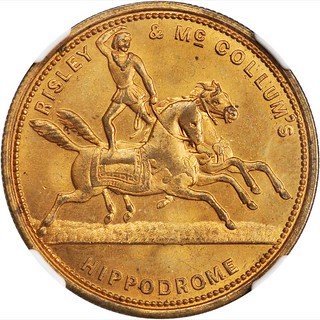
I hope you find this interesting. If you would like to pass this information to the owner of these coins I would be very happy. If they would like to contact me directly I would also be happy. As far as I know, no other researcher has ever tried to follow McCollum’s career before me. My interest in him arises from the subject of my research, a theatrical entrepreneur called John Washington Smith who managed for McCollum and Stone in America and was also involved in touring companies throughout Asia between 1861 and 1874.
Did any of our readers purchase this piece? It sold for $446.50. According to this research it's not an early American circus token, but one for an American performing in England.
I wondered, are any of our U.K. readers familiar with this piece? Have any appeared on the market there? And is that actually McCollum pictured on the token? Or is the rider Mr. Stone? Well, Margaret had some answers for me - her response is below. -Editor
Here are some other tokens that I also found on a web-site recently:
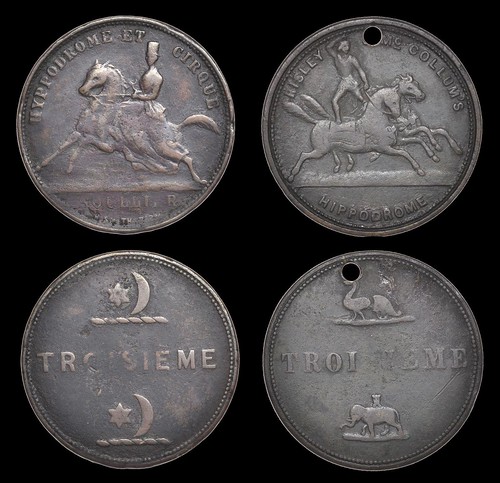
Tickets and Passes of London from the David Young Collection
TICKETS and PASSES, Circuses, Risley & McCollum’s Hippodrome, brass, man standing on two horses galloping right, risley & mccollum’s hippodrome around, rev. troisieme, ostrich pulling cart above, elephant and castle below, edge grained, 32mm, 9.60g (W 971); Louis Soullier, brass, by H. Smith, horsewoman cantering left, hippodrome et cirque soullier around, rev. troisieme, star and crescent crest above and below, 33mm, 8.38g (W 977) [2]. About fine, scarce; first pierced for suspension £60-80
Provenance: First W.J. Noble Collection, Part II, Noble Numismatics Pty Auction 61B (Melbourne), 3-4 August 1999, lot 752 (part), bt L. McCarthy November 2002; second bt September 2017.
Richard Risley Carlisle, aka Richard Risley (1814-74), showman and entrepreneur from Salem, NJ, in partnership with Thomas McCollum and their combined French and American equestrian troupe, performed in a circus at Drury Lane in 1851, which is when these tickets were issued. Louis Soullier (1813-88), proprietor of his self-styled Cirque Orientale, toured England in 1852, performing in London and Manchester, before taking his troupe to China, where they debuted in 1854 as that country’s first-ever circus
To read the complete Dix Noonan Webb lot description, see
https://www.sixbid.com/browse.html?auction=4939&category=148919&lot=4113879
There are some other tokens that depict McCollum as well. Madame Soullier is interesting as she joined the company in early 1852 as well. I am currently trying to follow up on the claim that Louis Soullier took his equestrian company to China in 1854. It is likley that Madadme Soullier was formerly Laura de Bach, the widow of Chritoph de Bach who founded Circus Gymnasticus in Austria- one of the first permanent Circus buildings in Europe in 1808 (Dominique Jando, Circopedia).
In relation to your material, the image is certainly of Thomas McCollum. He was famous for his two horse "jockey" act. Eaton Stone was famous as a bareback rider; he was abducted by Comanche Indians at one point in his life and he performed a famous Comanche Indian act as well.
"Professor" Richard Risley is also a very interesting character. His story is well recounted by Frederick Schodt in his book "Professor Risley and the Imperial Japanese Troupe; How an American Acrobat Introduced Circus to Japan" published by Stone Bridge Press, Berkeley California. The "he" of "he had his own company" is obviously McCollum- but it doesn't read clearly.
To read the complete lot description, see:
New York--New York. (Circa 1850s) Risley & McCollum's Hippodrome. Miller-NY 663 (type). Gilt brass.
(https://auctions.stacksbowers.com/lots/view/3-7KYG3)
To read the earlier E-Sylum article, see:
NUMISMATIC NUGGETS: MAY 21, 2017 : Risley & McCollum's Hippodrome Token
(http://www.coinbooks.org/v20/esylum_v20n21a23.html)

VOCABULARY TERMS: ALLEGORY AND PERSONIFICATION
Dick Johnson submitted this entry from his Encyclopedia of Coin and Medal Terminology. Thanks. -Editor
Allegory and Personification A design employing symbolism to express a metaphor in sculptural or medallic form. Allegory is employed in most every coin and medal design – other than portraits or realistic scenes (actual people, places, things) – thus its importance to numismatics cannot be overstated. Such design metaphors, coats of arms, national symbols, shields, mythical creatures, deities, trademarks, seals and symbols are all allegorical expressions appearing on numismatic or medallic items; but every nonexistent thing, as the device of a seated Liberty or standing figure, is an expression of allegory representing some concept the artist wishes to convey to the viewer.
 Ideas, abstract concepts, things both animate and inanimate, can be expressed in art. When expressed as a person (or with human traits) this is
personification; when shown by representative forms, this is allegory. (When shown by sample or example, this is exemplification.)
Allegory is the expression of the cornucopia for Abundance, the plow for Agriculture, the masks for Drama, the hand torch for Olympics, the capsule for Space Exploration.
Personification of music, for example, is the kneeling female playing a lyre on the reverse of the 1936 Cincinnati commemorative half dollar.
Ideas, abstract concepts, things both animate and inanimate, can be expressed in art. When expressed as a person (or with human traits) this is
personification; when shown by representative forms, this is allegory. (When shown by sample or example, this is exemplification.)
Allegory is the expression of the cornucopia for Abundance, the plow for Agriculture, the masks for Drama, the hand torch for Olympics, the capsule for Space Exploration.
Personification of music, for example, is the kneeling female playing a lyre on the reverse of the 1936 Cincinnati commemorative half dollar.
Allegory was the invention of the Greeks when they began to interpret ancient mythological figures (as certain universal or philosophical truths). Even Christian monotheism accepted personification of these mythical deities, but it was the growth of novel entities and symbols in the middle ages that lead to the widespread use of allegory in European literature, philosophy and art. Over the years the use of design metaphors have greatly increased and are now universal. The use of allegory in numismatics began with the earliest coins and continue to the present.
In designing coins and medals the designer is seeking a visual substitute for the concept he wishes to present. It is the responsibility of the designer that his choice of allegorical design should be appropriate and convey the symbolism accurately to the viewer, in addition to being attractive and proper for the medallic medium. The allegory should be understandable by a reasonably intelligent person and not be so mysterious, abstruse or occult that it is inexplicable.
The designer has a small canvas to prepare his or her numismatic or medallic design, but successful artists have expressed vast concepts in this small space. For a designer to prepare an exceptional bas-relief design he should eliminate all unnecessary detail, choose a device, allegory or symbolism of the concept he is trying to convey, then execute the design with style, verve and authority.
The designer should recognize several pitfalls in creating a coin or medal design. He should avoid design clichés much as a writer abhors trite and hackneyed phrases in writing. The designer should study the heritage of coins and medals and not continually repeat what has been done before. The designer should innovate. Also the designer should not oversimplify. An example of this was the personification of two youthful runners on the 1984 ten dollar gold Olympic coins. The mediocre design was termed "Dick and Jane" by a critical public.
The numismatist's responsibility – particularly when cataloging each piece for permanent record – is to recognize the allegory and explain it when it is not obvious. What, the numismatic researcher or cataloger must ask and answer, was the symbolism the artist, engraver or medallist trying to tell the viewer?
The greatest numismatic and medallic designs in history were those in which the artist completely understood the use of allegory and personification and utilized these concepts most artistically in his bas-relief works. See also design, symbols and symbolism.
References:
A30 {1971} Vermeule.
Image from NGC Coin Explorer:
SILVER COMMEMORATIVES 1936 D CINCINNATI 50C MS
(https://www.ngccoin.com/coin-explorer/silver-commemoratives-pscid-71/1936-d-cincinnati-50c-ms-coinid-19284)
Looking for the meaning of a numismatic word, or the description of a term? Try the Newman Numismatic Portal's Numismatic Dictionary at: https://nnp.wustl.edu/library/dictionary
Or if you would like a printed copy of the complete Encyclopedia, it is available. There are 1,854 terms, on 678 pages, in The Encyclopedia of Coin and Medal Technology. Even running two a week would require more than 19 years to publish them all. If you would like an advance draft of this vital reference work it may be obtained from the author for your check of $50 sent postpaid. Dick Johnson, 139 Thompson Drive, Torrington, CT 06790.
CHARLES DIETRICH REIMERS (1872-1946)
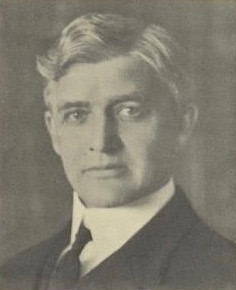 Reimers was a noted stamp and coin dealer in the 1920's. He seems to have had some business arrangement with B. Max Mehl not yet clearly understood. His office was
in same building as B. Max Mehl, the Flat Iron Building, Fort Worth, Texas.
Reimers was a noted stamp and coin dealer in the 1920's. He seems to have had some business arrangement with B. Max Mehl not yet clearly understood. His office was
in same building as B. Max Mehl, the Flat Iron Building, Fort Worth, Texas.
Charles Dietrich Reimers (1872-1946), born May 2, 1876 at Rock Island, Illinois, son of John Jacob Reimers (1843-1922), a native of Germany, and Marie “Marietta” Antoinette Denkman Reimers (1854-1934).
According to the 1880 U. S. Census they lived at 84 Fifth Avenue, Rock Island, Illinois. He was educated at Iowa State University and Northwestern University.
He was a first baseman on the Northwestern University baseball team. Member of Phi Delta Theta.
He is the nephew of Edward P. Denkman, of Weyerhaeuser & Denkman Lumber Company. His uncle died in 1929, leaving him $262,000 in his will.
He was the president of three concerns in the printing and publishing industry : Reimers Printing Company; Keystone Printing Company; Reimers Engraving & Electrotyping Company.
He was the publisher of the Davenport Times 1899-1902.
He moved to Fort Worth in 1902 coming from Davenport, Iowa.
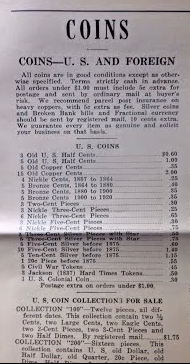 He purchased the old Mail Telegram newspaper and revived it as Fort Worth Telegram from 1902-1909.
He purchased the old Mail Telegram newspaper and revived it as Fort Worth Telegram from 1902-1909.
On October 30, 1906, he married Linda Ray Saunders (1883-1967) a native of Texas. They had three adopted children : two daughters : Ethleen Reimers Taggart (1918-1999), Linda “Inga” Reimers Mixson (1926-2005); and a son Carl D. Reimers (1930-2015).
In 1920, they owned a mansion at 425 Henderson Street, Fort Worth, Texas, and had a staff of four live-in servants.
He was the Vice-President, Texas State Bank.
He applied for ANA membership in January 1925. He became ANA Member No. 2785.
On June 10, 1946, he died of cerebral thrombosis complicated by pneumonia at his home 5000 Crestline Road, Fort Worth, Texas. He is buried at Greenwood Memorial Park.
To read the complete article, see:
REIMERS, CHARLES DIETRICH
(https://sites.google.com/a/numismaticmall.com/www/numismaticmall-com/reimers-charles-dietrich)
The entire inventory of the Lupia Numismatic Library is for sale. Individual items will be available before the remaining archives are broken up into parcels sold at philatelic auctions in the U. S. and Hong Kong. Check NumismaticMall.com frequently as dozens of new items with estimates will be posted daily until everything is sold.
All inquiries will be given prompt and courteous attention. Write to: john@numismaticmall.com .

SPENDING AN OLD $10 BILL: GOOD DEED GONE BAD
Author Kevin Flynn, like many of us, likes to put obsolete money back into circulation to help promote the hobby and make some new collectors. But sometimes the favor isn't appreciated. Here's an excerpt from his write-up of his recent ordeal. -Editor
Sometimes I use Buffalo nickels (struck 1913 through 1938) or Lincoln cents with the wheat back reverse (struck 1909 through 1958) in change. It’s neat to see the response of those receiving, usually a look of excitement. Our coins represent and reflect our country’s history. The images tell us of those places, people, events, and things that are important to past. I have found over the years that when coins, or even silver or gold are used as an investment, they are simply an object with the objective of making money. When there is a connection made to the symbology as to what the coin represents, or a time period in which they were struck, then is a much great enjoyment and respect of the coin.
Recently I went through some old currency I had and separated out those that I considered to be of little or no value above the face value of the currency, i.e. a $20 bill that was worth $20. I could have just went to a bank and traded them in for new bills. I decided instead to use them in circulation.
My hope was to inspire people to see them, find them cool, keep them, and start collecting. It is always fun to watch someone lighten up when you had them a Two dollar bill, normally I would see them put their own money in the register and keep the bill. I would normally wait there while they examined to see if there was any questions regarding the bill such as if it was worth a premium. In 30 years I have never had a problem in using old coins or currency in circulation to pay for merchandise or services (such as a tip). Until now.
What I did not contemplate or consider in using older currency for transactions is that individuals who did not know the United States used older currency that appeared different and had different attributes and characters. For example: there might be individuals who do not know that the United States has modified its currency over the years, such as the size, shape, font, and location of the lettering or the size, shape, location, color, and actual designs used, or the security measures included; there might be younger individuals who primarily use debit and credit cards have less experience with currency, especially with older currency; someone new in the country has not seen or dealt with older currency; someone uneducated. I have met some people who did not realize we have a $2 bill. Most individuals who I have used older currency with, such as an older $20 that contains a smaller image of Andrew Jackson have said that they remembered using the older $20s and recognized the bill.
I went to the Dollar Tree store in my area to buy some basic stuff. The total for all items was $10. I used one of my old Ten Dollar bills. The Cashier looked over the bill then put it in the drawer, I stood there until she put the bill in the drawer. Had she questioned the bill’s authenticity, I would have gladly replaced with another or used my credit card. On Friday October 12th , the local Sheriff’s Department office placed an article on their website showing a photo of me at Dollar Tree and a title stating that they were seeking the individual for using a counterfeit $10 bill at Dollar Tree. This article was picked up by local online internet news.
I work as a Department of Defense (DoD) contractor with my title being Senior Computer Scientist, which requires a security clearance. On Monday, October 15th , because of flash flood warnings in my area, I came into work late, around 10:30, went to my desk and started working. Several of the people I worked with walked by, looked at me and kept going. I learned later that some had seen my image on the police web site and also the local internet news sites. They had spent the morning before I got there wondering if I was on the run to Mexico, whether the base police would arrive to arrest me a drag me out in cuffs, whether I would be going to prison, and so on. Those of course who knew me, knew this is something I would not do. Around noon, my one of the people I work with came up to me and asked if I knew that I was wanted by the police. I was confused as this was out of the blue and he offered to show me. He showed me the police website, which had my image in the counterfeit article.
Long story short, Kevin reached out to the local police who were very professional and understanding, and the matter was eventually cleared up. -Editor

2018 U.S MINT FORUM REPORTS
I did not attend this year's U.S Mint Numismatic Forum, but understand it was a good event and debut for new Mint Director David Ryder. Here are a couple articles from the numismatic press. I enjoy Patrick Heller's writing and insights; here's an excerpt from a piece he wrote for Numismatic News. -Editor
Many new and interesting ideas were presented at the U.S. Mint’s third annual Numismatic Forum Oct. 17. This year’s event was held at the Bureau of Engraving and Printing in Washington, D.C. Perhaps 60-70 of us invited guests attended, along with numerous staff from the Mint and the BEP.
After a welcome from U.S. Treasurer Jovita Carranza, new Mint Director David Ryder (who had previously served as Mint Director from 1992-1993) explained his goals, visions, and plans, all of which indicated a greater receptiveness to public input and a broadened outlook on what the U.S. Mint might be able offer in the future.
Ryder was followed by brief presentations from Mint managers of different forthcoming 2019 numismatic programs, including commemoratives, Presidential silver medals, the American Innovation Dollar series (with the first coin to be released in late December 2018), and new products directed to appeal to young collectors.
The presentation on new products for young collectors was particularly enlightening. About 79 percent of Mint numismatic products sold directly to collectors go to people aged 55 and older. Most sales by the Mint destined to be owned by children are actually purchased by older customers, who then make gifts of the items.
Beyond looking for more products directed toward children, the U.S. Mint has begun discussions with some other mints, including the Royal Canadian Mint, Royal Australian Mint, and the Royal Mint about producing joint sets of coins and currency to be marketed by each mint with product included in the set.
As of the beginning of October, the Bureau of Engraving and Printing’s public sales are now being handled exclusively by the Mint (though the BEP will continue to handle its own dealer bulk sales program). One result has been an increase in BEP products being sold. Going forward, the Mint will look to expand offerings that include both coins and currency, especially incorporating military themes that are more popular than average with U.S. Mint customers.
Up to now, the U.S. Mint has generally accepted legislation directing what coins to produce and the specifications of them. Going forward, Ryder said that Mint staff would become more proactive at helping to write such legislation so as to incorporate ideas that would be of higher appeal to coin collectors.
A welcome addition to this year’s agenda was a panel on the problems of counterfeiting. Unfortunately, the four panelists only had a half hour, which was much too short to do much more than explain what is and what is not being done to combat this growing problem.
It was explained that the Mint is neither a policing or enforcing agency. Instead, it supports other federal agencies charged with these activities, such as the Secret Service and Customs and Border Protection. The Mint does review product returns to verify that they are not counterfeits.
Perhaps the best news from the panel discussing counterfeits is that since Ryder became Mint Director (where he had previously worked with anti-counterfeiting technology in the private sector), the Mint has begun discussions with the Royal Canadian Mint, British Royal Mint, Royal Australian Mint, and the marketing agency for the South Africa Mint as to what they are doing to combat counterfeits. (I think they should also contact the Perth Mint and Austria Mint as well.)
Overall, this year’s Numismatic Forum brought forth much more participation by the attendees. The sense I got is that Mint Director Ryder is much more open to outside ideas and has instilled that attitude among the other Mint staff in attendance at the event.
As a result, I judge this to be the most useful of the three Numismatic Forums thus far. Stay tuned to see if any of the ideas brought forth are actually incorporated. I am very much looking forward to attending next year’s Numismatic Forum.
Perhaps the most interesting (or alarming) announcement was that "the Mint will be going away from its historical depiction of Liberty in female form. Instead, some objects might be depicted, or significant historic events that allude to the concept of Liberty."
Heller raised another interesting possibility - "should the Mint and Bureau of Engraving and Printing merge?" -Editor
To read the complete article, see:
Mint forum hears new coin ideas
(http://www.numismaticnews.net/article/mint-forum-hears-new-coin-ideas)
A Coin World article highlights the lack of awareness at the mint about the counterfeiting of their products. -Editor
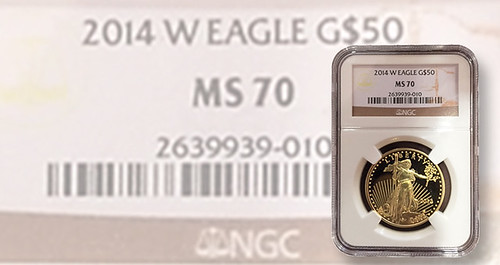
A triple fake - coin, holder and grading label are counterfeit
During an Oct. 17 Numismatic Forum, U.S. Mint officials were surprised that most of the more than 100 individuals invited had seen an example of a counterfeit United States bullion coin.
A three-member presentation panel on counterfeits featured Ron Harrigal, the Mint’s manager of design and engraving; Beth Deisher, former Coin World editor who is now director of the Anti-Counterfeiting Task Force under the Industry Council for Tangible Assets; and Walter Douglas, a senior industrial engineer in the Mint’s Quality Assurance Division.
Deisher was the only non-Mint representative to deliver remarks during the day-long forum, the third annual event staged by the Mint to address hobby and industry concerns.
Harrigal said Mint officials have been not directly exposed to counterfeit U.S. bullion coin products, made aware only through what they have read in the numismatic press. When he asked how many of those in attendance had seen a counterfeit U.S. bullion coin, nearly all hands were raised.
To read the complete article, see:
Mint officials surprised at forum participant response
(https://www.coinworld.com/news/us-coins/2018/10/anti-counterfeiting-panel-at-mint-numismatic-forum.html)

THE 1787 BRASHER DOUBLOON ELECTROTYPE
Craig Sholley submitted this story about the 1787 Brasher Doubloon Electrotype just auctioned by Stack's Bowers. Thanks! -Editor
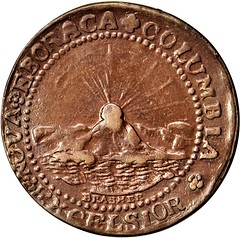
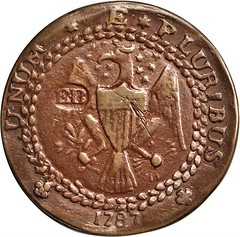
The Fantastic Dubois-W. Elliot Woodward Brasher Electrotype
Almost buried amongst and certainly overshadowed by the amazing assemblage of colonial and early Federal coinage in the Stack's Bowers October Baltimore sale this past Friday night was a lone electrotype of the famous 1787 Brasher or “New York” Doubloon. The cataloger had described it thusly:
1787 (ca. 1860s?) Brasher Doubloon electrotype. EB on Wing. Copper shells over lead.
156.4 grains. A remarkable electrotype copy, the first we have seen of this type, produced from the United States Mint Cabinet specimen now in the National Numismatic Collection
at the Smithsonian Institution. This carefully produced mid-19th century copy faithfully reproduces the distinctive characteristics of the Mint Cabinet specimen, including the old
scratch the original coin shows on the right side of the eagle's breast shield, the two dull depressions in the field above the sunrise, and the unique centering seen only on
that example of this famous rarity. One of just 6 known Brasher Doubloons with the punch on wing (and one of 7 of this type overall), the Mint Cabinet specimen was discovered by
Adam Eckfeldt in a bullion deposit in 1838 and plucked out for saving. It has been in the national collection ever since. This electrotype was likely made at the US Mint, a rare
relic of the 19th century and perhaps the only such copy known today.
As a collector of 19th century electro’s, I began researching the piece as soon as my “want-list” search on the Stack's Bowers site notified me it was coming up for sale and despite the fact that it’s a bit out of my collecting area (I’m particularly interested in pieces from Charles Enders, Jr.’s fixed price list from the 1880’s), I put in what I felt was a very strong bid of $5250.00 based on what I had found.
Since the title of this small article gives it away, I’ll cut straight to the point. In his April 28 to May 1, 1863 sale W. Elliot Woodward offered lot 2105, “A fine fac-simile of the New York Doubloon, Doubloon, made at the mint by Mr. Dubois.” The piece was purchased by Charles Bushnell for $2.50, but as Saul Teichman noted to me in an email, that piece does not appear in the 1882 sale of his collection, so it was obviously sold or traded some prior date.
Woodward subsequently sold another piece in his October 21 to 4, 1863 sale, lot 3061, described as “Copy of the New York Doubloon, a perfect fac simile, made by Mr. Dubois, at the mint, much finer than the one in my last sale.” The piece sold to Joseph Levick for $3.50, who subsequently sold it in his April 1865 sale where it brought but one dollar!
So, William Ewing Dubois, the son-in-law of Adam Eckfeldt and Curator of the Mint Cabinet, had, at some point in early 1863, produced two electrotypes of the 1787 Brasher Doubloon in the mint collection and traded hem to Woodward for some unknown pieces for the collection and the piece in the Stack's Bowers sale was, in fact, one of the two as it exactly replicates the centering and scratches seen on the Mint Cabinet piece. Whether this is the “finer” or lesser piece is unknown at this point, but does that really matter as it has one heck of an amazing history?
Collectors should be aware that the Dubois-Woodward pieces are definitely not the only electrotypes of Brashers that were available at the time and possibly exist to this day as Woodward sold another piece, not attributed to Dubois, in his October/May 1863 sale for fifty cents.
For those who may wonder if the electro might have been made at some point prior to the original piece being pulled from a bullion deposit by Adam, the answer in a word is no. The pieces that would become the Mint Cabinet were turned over by Eckfeldt in June of 1838 and in his 1846 tome “Pledges of History” Dubois notes the doubloon was in the collection at that point.
Since the first successful process for electrotyping was not demonstrated until October of 1838 by Mortiz Jacobi at the Russian Academy of Sciences and word of the process had not reached Western Europe and America until the end of that year, it’s obviously impossible for the piece to have been made outside the mint and the piece is thus one of the two traded to Woodward.
It should also be noted that the 1838 date many authors and catalogers use for the time period this and other pieces were placed in the collection is based on a misreading of an 1878 recollection by Dubois concerning the founding of the Mint Cabinet with Dubois noting the collection was formed some forty years ago. However, it is clear that Dubois is speaking generally and about the date Adam turned the coins over to the Mint Cabinet, not the date he found the pieces, which in most cases was much earlier.
I’ll close with a thank you to Tony Terranova who suggested I send this article to The E-Sylum. AS tony noted, “Every coin geek in the U.S. reads the E-Sylum. Why wouldn’t you send it to Wayne, it’s the perfect place to publish something like this.”
Greetings, coin geeks! I hope you enjoyed this as much as I did. Thanks for the great submission, Craig. -Editor

CIVIL WAR REDENOMINATED U.S. COINAGE
While compiling this week's NUMISMATIC NUGGETS I came across an interesting U.S. counterstamp. -Editor
1855 Half Cent Counterstamped "4 CTS"
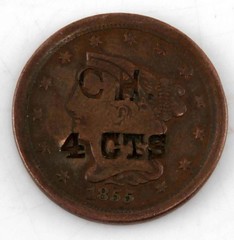
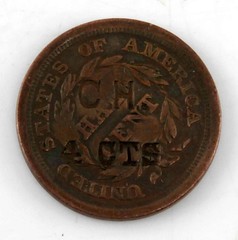
1855 COPPER U.S. HALF CENT TOKENIZED TOKEN
I collected U.S. Merchent counterstamps for years, but didn't recall one being revalued for use as a token. This piece appears to have been stamped with a value of four cents (spelled "4 CTS"). What purpose might this have served? -Editor
To read the complete lot description, see:
1855 COPPER U.S. HALF CENT TOKENIZED TOKEN (https://www.invaluable.com/auction-lot/-1-c-B4849BA831)
I reached out to a couple fellow counterstamp collectors for more information. -Editor
Bob Merchant writes:
This is a well known countermark. It's still a maverick (unattributed) as far as I know. I have seen several of these over the years, always on Half Cents. They are a mystery, like so many other countermarked coins. "CTS" was a common abbreviation of "Cents" during the 19th century (seen in old newspapers). It could have been used as a trade token/check, or it could have been used for something else entirely.
Bill Groom writes:
Coincidentally, I just penned an article about counterstamps being used to "redenominate" coins; this, for future publication in the National Token Collector Association's Talkin' Tokens journal.
The gist of it is that the practice of elevating the denomination of circulating cents seems to have been an early Civil War era phenomenon, given the shortage of then circulating coins. A great many Civil War and sutler tokens, many being cent-sized, were assigned values exceeding one cent, too. Akin to tokens, these redenominated coins were, in effect, an I.O.U. The 1855 half cent, elevated to the value of of four cents, is a maverick, I believe.
The Schiller pieces, Indian cents dated 1860, redenominated to ten times their face value, are perhaps the best known examples from this class of counterstamps. Here are three other examples from my collection

Redenominated U.S. Cents: H. Stein, Continental, Cameron House
If that scenario is true these are an important link in U.S. Civil War numismatic history. Had I been more aware of these at the time I would have sought them out for my Civil War numismatica collection. I believe I did own a Cameron House piece without fully realizing what I had. Thanks, everyone. Can any of our readers offer more examples or information? -Editor
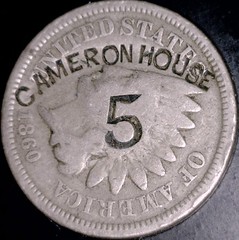
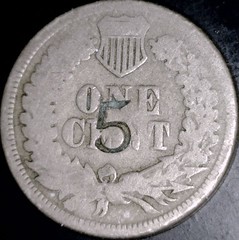
Bill adds:
Virtually all of the redenominated pieces I've seen have been dated during or near prior to the Civil War. Here's another CAMERON HOUSE piece; this one, dated 1860. Note that both the obverse and reverse are stamped with a 5. The reverse 5 was centered atop the ONE in ONE CENT.
It's been suggested by some that this hotel was located in La Crosse, Wisconsin, but that establishment wasn't built until 1879, when there was really no need to elevate the value of a cent to a nickel. Note that all of the CAMERON HOUSE pieces so far known exist on cents dated 1859 or 1860, the latest year. If my theory is correct, I've found a more likely candidate for this issue in Harrisburg, PA, and it was newly in business in 1859.

NUMISMATIC NUGGETS: OCTOBER 28, 2018
Here's a selection of interesting or unusual items I came across in the marketplace this week. Tell us what you think of some of these. -Editor
Bois Durci Medallion
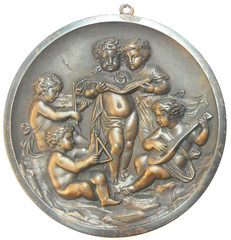
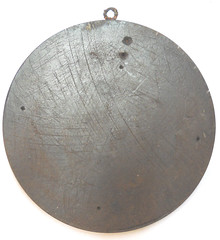
Bois durci music PUTTI MUSICIANS 162mm
This caught my eye partly because of the medium, bios durci, a hardened wood product made from sawdust, albumen and animal blood. While bois durci items are relatively rare, it's not unusual to see large items like this that would be difficult to strike in metal.
This is in the stock of E-Sylum supporter Hedley Betts. I checked with him on this, and buyers can ignore the "Does not ship to United States" notice. This listing is for potential U.K. buyers, but the piece is in the U.S. and can be shipped anywhere. -Editor
To read the complete lot description, see:
Bois durci music PUTTI MUSICIANS 162mm (https://www.ebay.com/itm/163318795310)
To read E-Sylum articles on bois durci, see:
BOOK REVEW: BOIS DURCI, A NATURAL PLASTIC 1855-1927, BY GASTON VERMOSEN
(http://www.coinbooks.org/esylum_v11n36a04.html)
MORE ON BOIS DURCI (http://www.coinbooks.org/esylum_v11n37a09.html)
WWI German Medal Man Battles Hydra
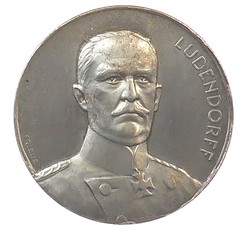
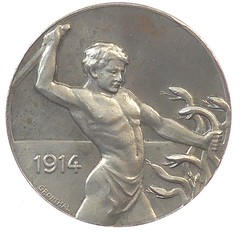
Here's one of Hedley's medals that caught my eye this week. I don't recall any other coin or medal designs featuring a hydra, but I'm sure there are some. Can anyone send us an image? -Editor
To read the complete lot description, see:
Germany World War I hydra nude GENERAL LUDENDORF zinc 35mm (https://www.ebay.com/itm/153230087551)
1962 Uruguary ANCAP Medal
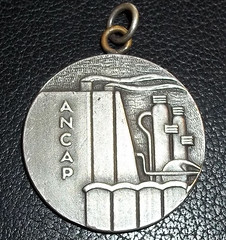
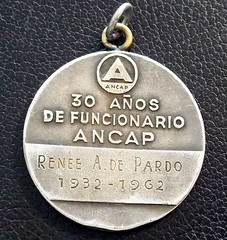
URUGUAY 1962 ANCAP PETROLEUM, PORTLANT CEMENT & ALCOHOL CIA PURE ART DECO SILVER
PETROLEUM, PORTLANT CEMENT & ALCOHOL COMPANY
"30 AÑOS DE FUNCIONARIO DE ANCAP"
30 YEARS OF OFFICER OF ANCAP
PURE ART DECO
SILVER MEDAL - MARKED "PLATA" ON THE EDGE
MEASURES: 31 MM DIAMETER
MATERIAL: SILVER
CONDITION: EXCELLENT
WEIGHT: 20,5 GRAMS
Well, it's Art Deco-like, even if it's not from the 1930s. I was attracted to this piece for its spare industrial design. It's not beautiful, but captures and evokes its subject well. -Editor
To read the complete lot description, see:
URUGUAY 1962 ANCAP PETROLEUM, PORTLANT CEMENT &
ALCOHOL CIA PURE ART DECO SILVER (https://www.ebay.com/itm/URUGUAY-1962-ANCAP-PETROLEUM-PORTLANT-CEMENT-ALCOHOL-CIA-PURE-ART-DECO-SILVER/232975028207)
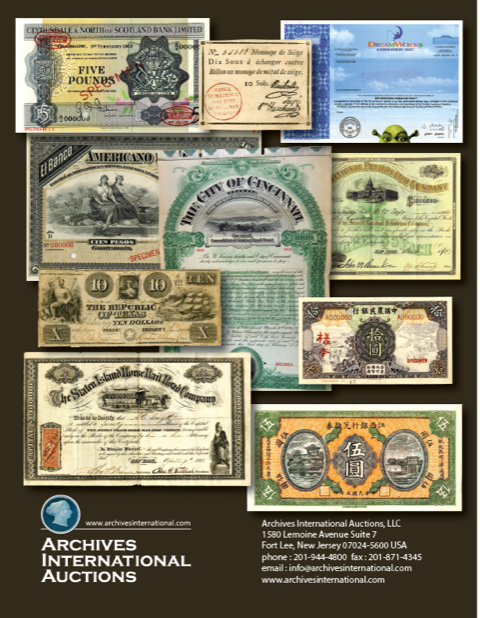
NEWMAN SALE X CURRENCY HIGHLIGHTS
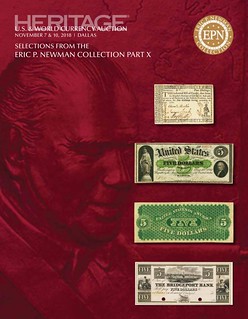
Here are some highlights from the upcoming Heritage sale X of currency from the Eric P. Newman collection. -Editor
Lot 20022: Georgia 1762 5 Shillings Native American
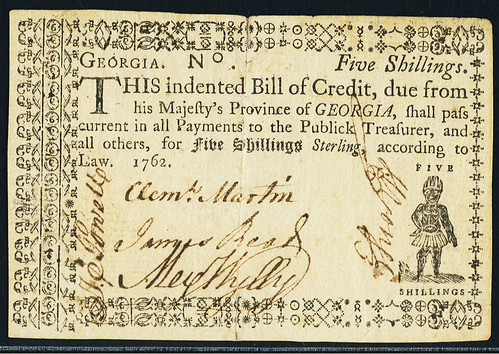
Historically Important 1762 Georgia Native American Vignetted Type
Province of Georgia 1762 5 Shillings Native American Fr. GA-40b. PCGS Extremely Fine 40 Apparent.
All notes from this 1762 Georgia series are rare. They saw heavy circulation and lower-denomination notes, like the 5 shillings, were printed on the stiffer laid paper that often
cracked or split quickly in commerce. This high-grade example is superior to the Boyd collection note, the Newman plate example, and nearly all others we have researched. It is a
charming, uniface, typeset 5 shillings bill featuring the folk-art style Native American at lower right between FIVE and SHILLINGS. The figure, grounded by some hatching, is in
black with white details for facial features, headdress, skirt, ribs, and musculature. His stance, with right arm bent and hand resting upon hip, and left arm slightly
outstretched, appears welcoming rather than menacing. A wide variety of type ornaments comprise the border.
The signatures of Clement Martin, James Read, and Alex Wylly are bold at the center; Powell's is perpendicular at the left, and Yonge's is perpendicular at the right. Despite noted "Edge Splits and Repairs," this is a bright, clean example. The laid paper is very natural and fresh when viewed from each side. Embossed type letters are visible from the back. The antique paper strip repairs are placed delicately at the top and bottom of the blank back. The majority known to us have been restored, often harshly, and do not enjoy this pleasing face appeal. Very underrated and undervalued in this sharp condition, and likely one of the finest extant.
This Native American looks more like a Hottentot, a native of South Africa. -Editor
To read the complete lot description, see:
Province
of Georgia 1762 5 Shillings Native American Fr. GA-40b. PCGS Extremely Fine 40 Apparent.
(https://currency.ha.com/itm/colonial-notes/georgia/province-of-georgia-1762-5-shillings-native-american-fr-ga-40b-pcgs-extremely-fine-40-apparent/a/3568-20022.s)
Lot 20206: $5 1861 St. Louis Demand Note
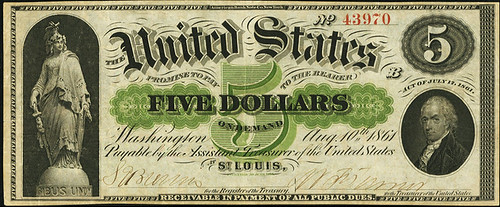
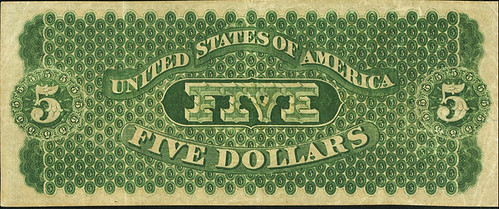
United States of America - Fr. 5 $5 1861 St. Louis Demand Note. PCGS Extremely Fine 40 Apparent.
All Demand Notes are rare, but the St. Louis Demand notes are the rarest in the series. There are ten examples of the St. Louis $5 Fr. 5 Demand Note currently listed on the census. This note was from the first material Eric P. Newman ever acquired from the "Colonel" Green Estate. It was among a $1,200 purchase of Missouri paper money (Eric had to borrow $600 as he hadn't yet entered into his partnership with B.G. Johnson.) Amazingly, this purchase included four St. Louis $5 Demand Notes. The present example is the finest of the four and has been in the Newman Collection for over 75 years. It is listed on Eric's original typed inventory (included in this sale catalog) along with the $10 St. Louis Fr. 10 Demand Note (obtained from Wismer in 1939) we sold in Newman Part VIII in for $168,000.
American numismatic history at its finest. This purchase was the first of a landmark acquisition of one of the greatest collections of U.S. numismatics ever formed. -Editor
To read the complete lot description, see:
United
States of America - Fr. 5 $5 1861 St. Louis Demand Note. PCGS Extremely Fine 40 Apparent.
(https://currency.ha.com/itm/large-size/demand-notes/united-states-of-america-fr-5-5-1861-st-louis-demand-note-pcgs-extremely-fine-40-apparent/a/3568-20206.s)
Lot 20109: Bridgeport Bank $5 Audubon Running Grouse Vignette Note
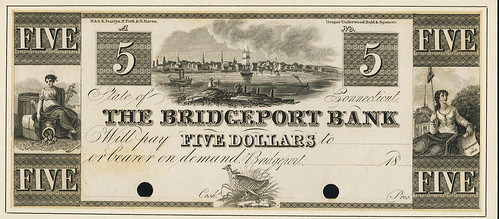
Bridgeport, CT - Bridgeport Bank $5 Audubon Running Grouse Vignette 18__ CT-25 G84. Proof. PCGS Very Choice New 64. Another exciting and very rare offering of a historic Obsolete note type. This proof also features the running grouse adapted after Audubon, using the original Fairman, Draper, Underwood & Co. die, but with a slightly later successor imprint. An India paper proof, affixed to new card. With the dual imprint of N. & S. S. Jocelyn, N. York & N. Haven/Draper, Underwood, Bald & Spencer. The period of this short-lived imprint combination indicates the plates were prepared in approximately 1840 (the first imprint printed the Territory of Florida notes for example, all hand-dated 1830), using the original Fairman, Draper, Underwood & Co. running grouse die at the base.
A superbly rendered design with a custom top central vignette of Bridgeport harbor. A couple in the foreground takes in the scene across the tranquil waters, viewing the buildings across the way. A ship appears anchored in the center and a small steamboat at the left is churning water as it prepares to pass. Flanking the vignette are "5" square dies on shaded lathe work. Plenty is seated at the left end and Liberty at the right end; each corner has FIVE on lathe work. The vignette of Audubon's running grouse is at the base.
This has an uncertain earlier pedigree (that is, before the American Bank Note Company archives sales) and possibly is the Haxby plate note (if that illustrated a photocopy). Published in the original Peck and Newman article as Figure 8b. A choice example, and a showpiece. The most recent Whitman Encyclopedia, volume 3 illustrates only a partially finished proof of this type. This might be unique as a finished proof, and it is unknown issued. Like all of these Audubon grouse-vignetted items, a key opportunity.
Eric's curiosity knew no bounds, leading him at age 99 to discover and document the grouse engraving as a long-lost Audubon print. Something for the numismatist, the bibliophile, and art collector all in one great piece. -Editor
To read the complete lot description, see:
Bridgeport,
CT - Bridgeport Bank $5 Audubon Running Grouse Vignette 18__ CT-25 G84. Proof. PCGS Very Choice New 64.
(https://currency.ha.com/itm/obsoletes-by-state/alabama/bridgeport-ct-bridgeport-bank-5-audubon-running-grouse-vignette-18-ct-25-g84-proof-pcgs-very-choice-new-64/a/3568-20109.s)
Lot 20014: 1574 Netherlands Siege of Leiden 5 Stuiver
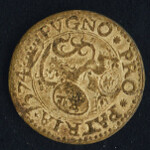

Netherlands - Siege of Leiden 5 Stuiver 1574 P-S101b. PCGS New 62.
One of most fascinating historical currencies in the Newman Collection. It may be classified as the earliest European paper money, but it is also properly classified with siege coins. Issued during the early part of the Eighty Years War (1568-1748) when the Spanish were holding siege around Leiden's dikes.
Generally, siege coins were struck upon citizens' silver plate and copper, church vessels, or anything that could be put to emergency use for money. In this intriguing case, shredded prayer books and bibles were made into a macerated pulp and formed into pressed cardboard-like sheets. The sheets were than impressed with dies and either struck in collars or trimmed into perfectly round "coins."
The face (obverse) has arms and rampant lion at center surrounded with motto PUGNO PRO PATRIA (I fight for my country) and date 1574. The reverse with fancy bordering and inscription LVG/DVNVM/BATAVO/RVM (Leiden in Batavia). This is a top-grade example. Perfectly round and struck-up well on both sides, particularly the back (reverse). There is a short fissure observed on the back as made, but the face looks perfect.
Superior to the Neil Shafer "Money of the People" collection example which had some adhered wax from an old seal and realized $3,450 in June 2014. Rarely offered, especially in American sales. This is an important artifact reflecting the tumultuous wars crossing Europe centuries ago and the unusual emergencies created.
I had no idea Eric collected these but I guess I'm not surprised. Very rare and historically important. -Editor
To read the complete lot description, see:
Netherlands - Siege of Leiden 5 Stuiver 1574
P-S101b. PCGS New 62.. ... (https://currency.ha.com/itm/world-currency/netherlands-siege-of-leiden-5-stuiver-1574-p-s101b-pcgs-new-62/a/3568-20014.s)
Lot 20111: Government of Norton the First 50 Cents
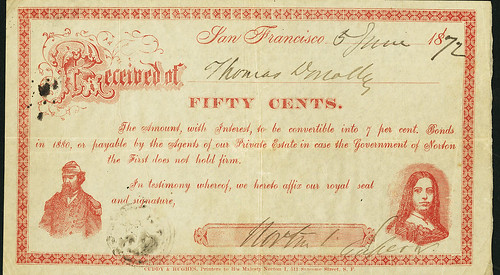
The story of folk hero Joshua A. Norton, who on September 17, 1859, proclaimed himself Norton I, Emperor of the United States and Protector of Mexico, is intriguing. Like countless others, he was drawn to San Francisco in 1849 by the Gold Rush. Although prosperous for a number of years as a commission merchant and entrepreneur, he lost all his money in 1858 after the collapse of the market for rice.
Whether his delusion of being emperor was caused by the shock of his insolvency, or perhaps dementia, Norton believed that he was indeed the Emperor of the United States and acted accordingly, issuing "bonds," which he used as currency, and collecting "taxes," in cash by means of personal visits. What is astonishing is that San Francisco's citizens rallied around him with compassionate deference.
Joshua Norton died suddenly on January 8, 1880, and his funeral drew tens of thousands of mourners. Interest in his life and legacy was rekindled in 2013 by writer John Lumea. Citing Norton's 1872 proclamation decreeing that "a suspension bridge be built from Oakland Point to Goat Island, and thence to Telegraph Hill," Lumea embarked upon a campaign to name the San Francisco-Oakland Bay Bridge after Emperor Norton (emperorsbridge.org). Norton lives on in film and television episodes, including Bonanza, which are available for viewing on the Newman Numismatic Portal.
An extremely rare and early date example of this historic American "currency" issued by the enigmatic Joshua Norton, as "Emperor" of his self-proclaimed domain. Norton's personal popularity in San Francisco allowed him to pass these "convertible bonds" for goods and services, such as his nightly rent at a boarding house, for close to a decade. Twenty years before this note was issued, he was successful and wealthy. His speculation in rice imports led to his financial doom and the lawsuits that followed. Whether he reinvented himself by plan or madness is speculation. However, the Norton I notes are among the most popular Obsolete currency subjects and western paper Americana documents.
The Newman Collection contains three different examples, all representing different obligation series. Uniface, lithographed in all red on white rag paper. 20.4 cm x 11.7 cm. The imprint, under the base frame line, is custom to the issuer: CUDDY & HUGHES, Printers to his Majesty Norton I, 511 Sansome Street, S. F. Supposedly, Norton was not charged for the printing costs and this imprint served as an advertisement for the firm. Ornate borders contain the obligations and two vignettes: Norton in uniform at lower left, and a young woman with hair in ringlets at lower right. Along the top, an ornate "Received of" is followed by the line for the recipient of the bond's signature. "San Francisco" and a handwritten date line are to the upper right. The obligation is in five lines: "The Amount with Interest, to be convertible into 7 per cent. Bonds/ in 1880, or payable by the Agents of our Private Estate in case the Government of Norton/ the First does not hold firm./ In testimony whereof, we hereto affix our royal seal / and signature," signed Norton I, Emperor on the shaded block below, with a black ink stamping to the left . Unnumbered. Marckhoff Type 2 (Numismatic Scrapbook, March 1982, pp.671-682).
The illustrated example in that article was credited to the California State Historical Society (that dated July 3, 1872). This type was missing from major publicly offered collections from the past decades including Clifford and Ford. It is the first red printed note we have cataloged and is a very distinctive type. The later Norton I types frequently realize in excess of $10,000 each. This is worthy of exceeding that level handily due to its much greater rarity and excellent condition.
Emperor Norton was an American original. I've always wanted to own a Norton bond but have had to satisfy myself with reproductions. Historically important and interesting as all get-out. -Editor
To read the complete lot description, see:
San Francisco, CA - (Imperial) Government of Norton the First 50 Cents "Convertible into 7% Bonds in 1880 or Payable by Agent...
(https://currency.ha.com/itm/obsoletes-by-state/california/san-francisco-ca-imperial-government-of-norton-the-first-50-cents-convertible-into-7-bonds-in-1880-or-payable-by-agent/a/3568-20111.s)
Lot 20068: Continental Currency $30 Contemporary Counterfeit
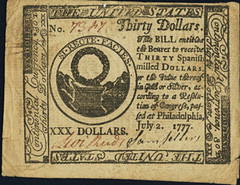
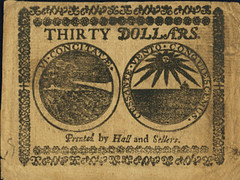
Continental Currency. May 20, 1777 dated July 2, 1777 $30 Newman 1.1 Contemporary Counterfeit Fr. CC-70CF. PCGS About New 50 Apparent.
An extremely distinctive counterfeit First United States Notes with a fictitious date. Exceedingly rare and the only example known to us. No. 7327. Printed on thin paper from a single-impression plate, wide margins still present.
Diagnostics:
This bill has a fictitious date of issue. It was copied from the May 20, 1777, issue.
Newman 1.1: Engraved
On the face: In the text, the ea and er of Bearer are joined. The i of in touches the line to its left. There is a period rather than a comma after July 2 in the date.
On the back: The upper right loop of the P in Printed is completely formed. On the genuine bill, the upper right loop of the P in Printed is mostly missing. The last s in Sellers is tilted slightly to the right.
Noted "Edge Tear near LR Corner." The fault is minor. A fascinating example and this would certainly be a prize note in any Continental Currency collection.
Contemporary counterfeits circulated right alongside the genuine examples, and are rarities today in their own right. Fascinating item. -Editor
To read the complete lot description, see:
Continental Currency. May 20, 1777 dated July 2, 1777 $30 Newman 1.1 Contemporary Counterfeit Fr. CC-70CF. PCGS About New 50 ..
(https://currency.ha.com/itm/colonial-notes/continental-congress-issues/continental-currency-may-20-1777-dated-july-2-1777-30-newman-11-contemporary-counterfeit-fr-cc-70cf-pcgs-about-new-50/a/3568-20068.s)
To read the complete sale catalog on the Newman Portal, see:
Selections from the Eric P. Newman Collection Part X
(https://nnp.wustl.edu/library/auctionlots?AucCoId=8&AuctionId=524639)

NEWMAN SALE XI VOLUME 1 COIN HIGHLIGHTS
Here are some highlights from the upcoming two-volume Heritage sale XI of the Eric P. Newman collection. -Editor
Volume 1:
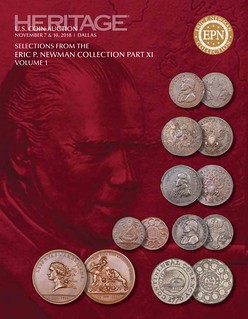 Rarities in the coin section include: the Newman 1-B 1776 Continental Dollar graded NGC AU55; the silver 1792 Washington Getz Pattern half dollar graded NGC X45; and the
1792 Washington President pattern in silver graded XF Details by NGC, one of only five known, with two of those held by institutions. The near-Gem bronze Libertas Americana
presented here is an original strike NGC MS64 Brown. Additionally, there are multiple Wyatt copies of Massachusetts silver, and 19th century Colonial copies by Bolen and
Robinson.
Rarities in the coin section include: the Newman 1-B 1776 Continental Dollar graded NGC AU55; the silver 1792 Washington Getz Pattern half dollar graded NGC X45; and the
1792 Washington President pattern in silver graded XF Details by NGC, one of only five known, with two of those held by institutions. The near-Gem bronze Libertas Americana
presented here is an original strike NGC MS64 Brown. Additionally, there are multiple Wyatt copies of Massachusetts silver, and 19th century Colonial copies by Bolen and
Robinson.
Lot 15002: 1776 Continental Dollar, CURENCY, Pewter
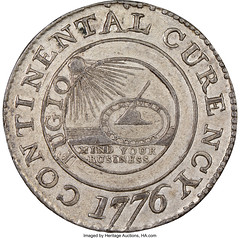
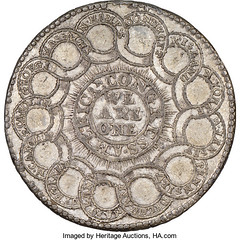
1776 $1 Continental Dollar, CURENCY, Pewter AU55 NGC. Newman 1-B, Breen-1086, Hodder 1-A.2, W-8435, High R.7. Pewter examples of the 1-B variety were unknown to Eric P. Newman in 1953. They are considerably rarer than brass examples of the variety, which makes this Choice About Uncirculated pewter example an important opportunity for Colonial specialists. We know of just six surviving coins struck in pewter from the 1-B die pair. In comparison, more than a dozen brass strikings are known from the 1-B dies.
The 1-B variety shares its obverse with the 1-C. Only a few distinguishing features separate the two varieties. In its early die state, the 1-C obverse is nearly identical to 1-B, although later states show a diagnostic die crack above GIO in FUGIO. The reverse of the 1-B shows crude reworking of the die to strengthen the linked circles, which were previously formed from a series of disconnected dots as seen on the 1-A variety. On 1-B, traces of the original dots remain clearly visible along the edges of the now-solid rings. Die lapping and additional die reworking on 1-C altogether eliminates the dots. Rays outside the center ring near RESS of CONGRESS come fully formed on Newman 1-B, but they are often attenuated on 1-C in mid-to-late die states. A pellet-like die chip near the Pennsylvania ring center of this 1-B is clear to the unaided eye, a feature that is absent on 1-C examples.
While the origin and purpose of the 1776 Continental dollar has long been an intriguing topic of discussion among numismatists and researchers, Eric P. Newman believed that these coins were American-made. Further, the fact that the Continental Currency paper $1 notes were eliminated from the six issues from July 22, 1776, through September 26, 1778, indicates that Congress planned for a $1 coin, and that the Continental dollar was used as fiat money. Multiple varieties of the Continental dollar exist, and varying quantities of coins were struck in pewter, brass, and silver from multiple die combinations and die stages. Today, there are either six or seven pewter Newman 1-B dollars confirmed, depending on the status of the 1968 Merkin coin.
To read the complete lot description, see: 1776 $1 Continental Dollar, CURENCY, Pewter AU55 NGC. Newman 1-B, Breen-1086, Hodder 1-A.2, W-8435, High R.7... (https://coins.ha.com/itm/colonials/1776-1-continental-dollar-curency-pewter-au55-ngc-newman-1-b-breen-1086-hodder-1-a2-w-8435-high-r7/a/1283-15002.s)
Lot 15009: 1792 Washington Getz Pattern Half Dollar
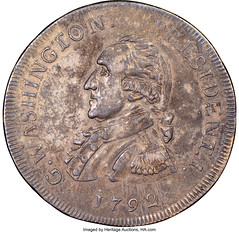
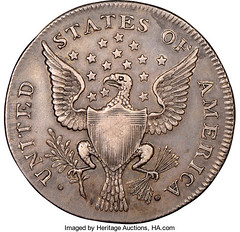
1792 50C Washington Getz Pattern Half Dollar, Small Eagle, Silver, Plain Edge XF45 NGC. Baker-24, W-10780, Musante GW-22, Low R.7. 35.2 x 34.2 mm., 190.3 grains. George Fuld's accounting of silver Getz pattern half dollars in The Washington Pattern Coinage of Peter Getz enumerated just 22 examples of all variants. Those variants include five examples with a Circles and Squares edge, all showing undertype; three examples with the intertwined olive leaves edge and one with a lettered edge, also all showing undertype; four examples with a plain edge that show undertype; and nine examples with a plain edge that have no evidence of undertype, including the piece offered here that Fuld recorded as number four in his list. Seven of the 22 silver Getz pattern half dollars are held in museum collections, including the Smithsonian Institution, the Massachusetts Historical Society, an Austrian museum, the Pennsylvania Historical Society, the Durham Western Heritage Museum, the Museum of Connecticut History, and the Colonial Williamsburg Foundation.
Although 13 of the 22 examples are overstruck, showing traces of undertype, it is probably the case that all silver examples were struck over some sort of existing silver coin. The absence of visible die rust on the reverse evidences an early striking. The weight of the Newman specimen is similar to early French half ecus struck before 1726. This pewter-gray example has dappled navy and gold toning on the obverse, and delicate gold and ivory toning on the reverse. The obverse has nearly complete border details, absent only from 11 to 1 o'clock. Reverse border dentils are present from 11 to 4 o'clock. This is an extremely important opportunity to acquire one of the rare Getz pattern half dollars struck in silver. This piece was exhibited at the 1914 American Numismatic Society's Exhibition of U.S. and Colonial Coins.
To read the complete lot description, see: 1792 50C Washington Getz Pattern Half Dollar, Small Eagle, Silver, Plain Edge XF45 NGC. Baker-24, W-10780, Musante GW-22, Low... (https://coins.ha.com/itm/colonials/1792-50c-washington-getz-pattern-half-dollar-small-eagle-silver-plain-edge-xf45-ngc-baker-24-w-10780-musante-gw-22-low/a/1283-15009.s)
Lot 15007: 1792 Washington Silver Pattern, Lettered Edge
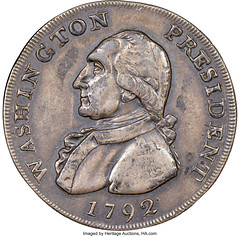
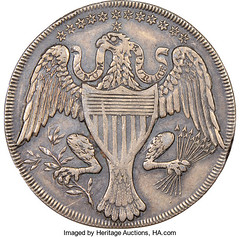
1792 CENT Washington Silver Pattern, Lettered Edge, Baker-20, Breen-1231, Musante GW-31 (B), High R.7 -- Obverse Graffiti -- NGC Details. XF. Ex: Picker. The silver 1792 Washington President, Large Eagle pattern, designated Baker-20, is among the rarest issues in all Washington coinage. Just five examples are known, only three of which are privately owned. The other two coins reside in institutional collections: one in the Massachusetts Historical Society, and the other in the Historical Society of Pennsylvania. The Massachusetts Historical Society coin is arguably the finest piece known. It was donated in June 1905 by the estate of William Sumner Appleton, who was a prominent 19th century collector. The other institutional coin is holed and plugged, and was donated to the Historical Society of Pennsylvania by William S. Baker. Baker is believed to have acquired it in W.E. Woodward's May 1888 sale of the Vicksburg Collection. It was previously the coin owned by A.S. Jenks of Philadelphia, whose collection was auctioned by Edward Cogan in April 1877.
The Appleton and Jenks coins were two of four pieces known to Crosby in 1875. In The Early Coins of America, Crosby named Charles I. Bushnell and Lorin G. Parmelee as the owners of two other pieces. Parmelee acquired Bushnell's coin in 1882, and it is that piece which was later sold with Parmelee's collection in June 1890. The Chapman brothers acquired it, and the coin later passed through the collection of "Col." E.H.R. Green, among others, and ended up in the possession of John J. Ford, Jr. It last appeared publicly in Stack's May 2004 sale of the Ford Collection, where it sold for $115,000. The piece Parmelee owned in 1875 was sold or traded prior to 1890. Today, it is either the John L. Roper coin or the Eric P. Newman example.
Baker-20 has a lettered edge. Most modern references list a Plain Edge silver variety, designated Baker-20A, but it is our opinion that such a coin does not exist. Our exhaustive study of auction listings going back to the early 1860s fails to reveal any confirmed appearance of a Plain Edge coin, and no such piece is known today. The origin of the so-called Plain Edge silver issue appears to be George Fuld's notes on the variety in the 1965 reprint of Baker's 1885 seminal reference on Washington coins and medals. Fuld states simply that "four or five plain edge" coins are known. Baker's original reference made no mention of a Plain Edge variant. Where Fuld got his information is unknown, although it is possible that the supposed Plain Edge variety was the result of misinterpreting early auction descriptions of silver Getz half dollar patterns as appearances of Baker-20, compounded by the fact that a few early Baker-20 auction listings do not mention the edge lettering. In any case, while copper coins are known with plain and lettered edges, it is believed that silver pieces exist only of the lettered edge type.
We are pleased to offer the Newman coin in its first known public auction appearance. NGC denies this piece a numeric grade due to a few faint pinscratches on Washington's portrait and what appears to be a crude letter "D" in the left adjacent field. However, these are virtually undetectable by the naked eye. The toned olive-gray and gunmetal-blue surfaces deliver an old-silver appearance, and the design elements exhibit little wear. The edge lettering is clear.
To read the complete lot description, see: 1792 CENT Washington Silver Pattern, Lettered Edge, Baker-20, Breen-1231, Musante GW-31 (B), High R.7 -- Obverse Graffiti (https://coins.ha.com/itm/colonials/1792-cent-washington-silver-pattern-lettered-edge-baker-20-breen-1231-musante-gw-31-b-high-r7-obverse-graffiti-/a/1283-15007.s)
Lot 15010: Libertas Americana Medal
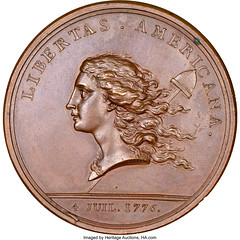
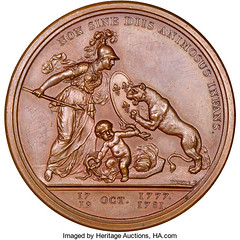
(1781) Medal Libertas Americana Medal MS64 Brown NGC. Betts-615, Loubat-14. It is safe to say that most British loyalists were not pleased by either the design or the intent of Benjamin Franklin's Libertas Americana medal, which extolled the role France played in the American War of Independence while chiding the British for their humiliating defeats at Yorktown and Saratoga. There was no mistaking the symbolic imagery of Minerva (France) protecting the infant Hercules (America) from a rampaging lion (England), while the precocious infant strangled a pair of serpents (Burgoyne and Cornwallis).
Meanwhile, dignitaries in France and America could not have been more delighted with the message and the impressive artistry of the medal. Based on a sketch by Esprit-Antoine Gibelin and engraved by Augustin Dupré, the medal was struck at the Paris Mint circa 1781. Page 102 of the 2019 Guide Book estimates that no more than 100 to 125 original bronze medals survive, plus two dozen or slightly more silver pieces. This near-Gem bronze example exhibits even, chocolate-brown surfaces with nearly unmarked, well-preserved, and partially reflective surfaces. A small die defect at the border below the 4 in the date of the obverse exergue confirms this piece as an original strike. Traces of die rust, as struck, are diagnostic of the original medals. The Libertas Americana medal ranks #1 by a wide margin in Jaeger and Bowers' 100 Greatest American Medals and Tokens.
To read the complete lot description, see: (1781) Medal Libertas Americana Medal MS64 Brown NGC. Betts-615, Loubat-14.... (https://coins.ha.com/itm/colonials/-1781-medal-libertas-americana-medal-ms64-brown-ngc-betts-615-loubat-14/a/1283-15010.s)
To read the complete sale catalog on the Newman Portal, see:
Selections from the Eric P. Newman Collection Part XI (volume 1)
(https://nnp.wustl.edu/library/auctionlots?AucCoId=8&AuctionId=524637)

NEWMAN SALE XI VOLUME 2 LITERATURE HIGHLIGHTS
Here are some more highlights from the upcoming two-volume Heritage sale XI of the Eric P. Newman collection. -Editor
Volume 2:
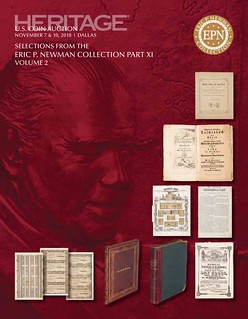 Volume 2 features items from Eric P. Newman’s library, including his correspondence files as well as the archives of Roger S. Cohen, Jr. and R. Tettenhorst (Bernard
Edison). Rarities include 19th- and early 20th-century plated auction catalogs. Within the important early references are three copies of Eckfeldt and DuBois with actual samples
of California gold, both editions of Edward Maris’s guide to 1794 large cents, and two copies of Edward Maris’s New Jersey tome. The cataloging is preceded by David Fanning's
entertaining introduction to the Library section, which details important information about terminology, abbreviations, and digitization.
Volume 2 features items from Eric P. Newman’s library, including his correspondence files as well as the archives of Roger S. Cohen, Jr. and R. Tettenhorst (Bernard
Edison). Rarities include 19th- and early 20th-century plated auction catalogs. Within the important early references are three copies of Eckfeldt and DuBois with actual samples
of California gold, both editions of Edward Maris’s guide to 1794 large cents, and two copies of Edward Maris’s New Jersey tome. The cataloging is preceded by David Fanning's
entertaining introduction to the Library section, which details important information about terminology, abbreviations, and digitization.
A special offering is the Eric P. Newman Collection of Heath’s Counterfeit Detectors, the subject of his 1991 article that appeared in the American Numismatic Association Centennial Anthology. The article is reprinted in this volume with permission of the ANA. Newman’s collection includes 64 lots in the Signature session that appear in the present volume, along with six additional lots that are recorded in volume I.
Two uncommon pieces in this sale are located in St. Louis. First is Eric P. Newman's Wooton desk, his workspace for over 40 years and an object of beauty in its own right. Second is B.G. Johnson's historic cabinet, which held the inventory of the St. Louis Stamp and Coin Company and later housed coins from Eric's collection. Numismatists can surely imagine working at Eric's desk and placing pieces from their collections within the drawers that held coins owned by "Colonel" E.H.R. Green, B.G. Johnson, and Eric P. Newman.
Lot 15105: Roger Cohen Numismatic Archives
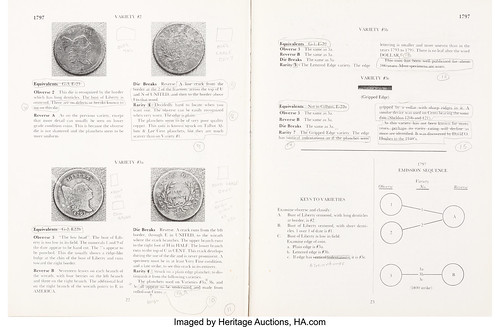
Cohen, Jr., Roger S. Numismatic Archives Pertaining to United States Half Cents. Seven boxes of Cohen's personal archives, including manuscripts, typescripts, and other pre-publication materials for both editions of Cohen's American Half Cents, voluminous correspondence with other half cent specialists, collection inventories, research papers, annotated catalogues and other printed materials, photographs, invoices for both coins and books, business documents regarding the printing and distribution of his books, and other matter concerning the study and collecting of U.S. half cents.
Roger S. Cohen, Jr. (1927-1990) was an accountant by vocation and a numismatist by avocation, whose focus became the study of the United States half cents, a series he felt had lived for too long in the shadow of their "big sisters," the long-studied and much-beloved large cents. Unsatisfied with the existing works on the subject and impatient with the slow progress being made by others in the field, he determined to write his own guide to the series, publishing the first edition of American Half Cents: The "Little Half Sisters" in 1971. The book was well-received, and a second edition was published a decade later in 1981. Cohen wrote that his book was "aimed at the person who has been collecting for a number of years and has an interest in coins but needs to get into something else other than date collecting or the filling the holes in the album routine..." (letter to Paul Munson, July 12, 1971). Writing and maintaining the book became the focus of his numismatic activities, with him acknowledging that it was "one hell of a lot more work than I ever dreamed."
To read the complete lot description, see: Cohen, Jr., Roger S. Numismatic Archives Pertaining to United States Half Cents. ... (Total: 7 items) (https://coins.ha.com/itm/books/cohen-jr-roger-s-numismatic-archives-pertaining-to-united-states-half-cents-total-7-items-/a/1283-15105.s)
Lot 15144: Tettenhorst Numismatic Archives
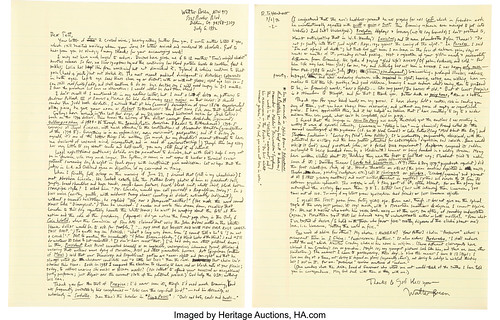
Tett's personal correspondence constitutes a remarkable portrait of serious coin collecting in the second half of the 20th century and the beginnings of the next. As a record of the world of early copper, it is unparalleled. It is at times highly informative, and at other times amusing. His kindness, warmth, and humor are almost always on display, and his peacemaking personality comes through as he attempts to play diplomat between the Cohen and Breen camps in the Half Cent War. He took amusement in the fact that he had become famous in the coin collecting world, while most people continued to be ignorant of his actual name.
The Tettenhorst Archives
Tettenhorst, Robert (pseud. Bernard Edison). Numismatic Archives of Bernard Edison, a.k.a. R. Tettenhorst. Ten boxes of correspondence, invoices and purchase records, research
papers, photographs, and other material primarily related to Edison's numismatic activities (conducted under the name of R. Tettenhorst), but also touching on various other
topics. 1952-2014. Edison donated his numismatic archives to the Eric P. Newman Numismatic Education Society (EPNNES).
To read the complete lot description, see: Bernard Edison (1928-2018).... (Total: 10 items) (https://coins.ha.com/itm/books/bernard-edison-1928-2018-total-10-items-/a/1283-15144.s)
Lot 15207: Eckfeldt and DuBois
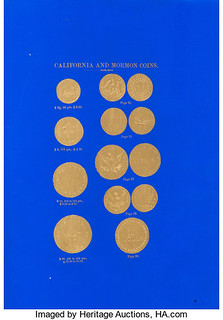
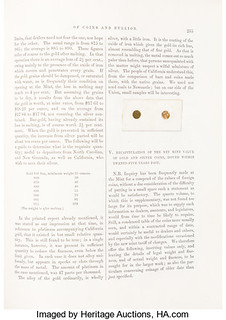
Eckfeldt, Jacob R., and William E. Du Bois. A Manual of Gold and Silver Coins of All Nations, Struck within the Past Century... [bound with] Supplement to the Manual of Coins and Bullion. [bound with] Addenda and Corrections, to June, 1851. Philadelphia: Published at the Assay Office of the Mint, 1842-1851. Small 4to, contemporary brown half morocco with mottled sides; spine with five raised bands, lettered in gilt. (4), iv, (5)-220; (221)-240; (241)-242 pages; fine frontispiece engraving of the Mint building; 16 attractively engraved plates of coins, all on coated paper with original tissue guards; very fine plate of California and Mormon coins printed in gold and in relief on a royal blue background; two actual samples of California gold on page 235 mounted under a small cardboard rectangle with round windows to allow viewing.
The extremely rare December 1849 supplement comprising pages 221-240 contains the attractive plate of California and Mormon gold coins, the tipped-in Mormon plate, and the first appearance of the famous California gold samples. This copy also includes the even more rare (if less significant) 2-page 1851 addenda, including a depiction of the new three-cent silver piece. Fine. Estimate $4,000.
To read the complete lot description, see: Eckfeldt, Jacob R., and William E. Du Bois. A Manual of Gold and Silver Coins of All Nations, Struck within the Past Centu... (https://coins.ha.com/itm/books/eckfeldt-jacob-r-and-william-e-du-bois-a-manual-of-gold-and-silver-coins-of-all-nations-struck-within-the-past-centu/a/1283-15207.s)
Lot 15332: Maris Guide to 1794 Large Cents
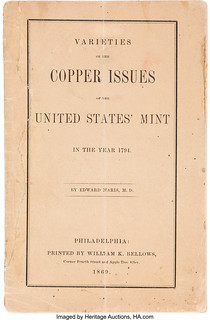
Maris, Edward. Varieties of the Copper Issues of the United States Mint in the Year 1794. Philadelphia: Printed by William K. Bellows, Corner Fourth Street and Apple Tree Alley, 1869. Small 8vo [18 by 12 cm], original printed paper covers. 15, (1) pages. Minor discoloration to covers; old fold down the center. Very good. This is the first separately published work on United States cents and half cents. Remembered beyond its landmark status mostly for the colorful appellations given by Dr. Maris to the 39 varieties of 1794 cents that he managed to identify: the Coquette, Scarred Head, Venus Marina, Roman Plica, Double Chin, Patagonian, and so on. Rare: only a fraction of the 100 copies originally printed appear to have survived.
To read the complete lot description, see: Maris, Edward. Varieties of the Copper Issues of the United States Mint in the Year 1794. ... (https://coins.ha.com/itm/books/maris-edward-varieties-of-the-copper-issues-of-the-united-states-mint-in-the-year-1794/a/1283-15332.s)
To read the complete sale catalog on the Newman Portal, see:
Selections from the Eric P. Newman Collection Part XI (volume 2)
(https://nnp.wustl.edu/library/auctionlots?AucCoId=8&AuctionId=524638)
THE BOOK BAZARRE
MOUNTING COINS FOR MUSEUM EXHIBITS
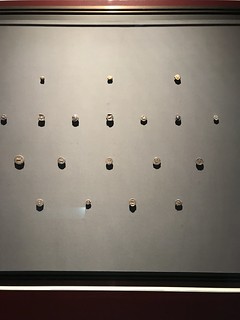
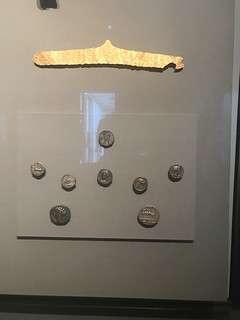
Alan Weinberg writes:
My wife visited the Malibu Getty mansion last week and photo'ed these two display cases of superb ancient Greek coins. I was concerned about how they were mounted and asked around. Andy Lustig contacted American Numismatic Society Executive director Dr. Ute Wartenberg Kagan.
First some background. The coins in the exhibit belong to the ANS. Here's a note from the June 2018 issue of the ANS E-News. -Editor
The Getty Villa
After three years of work, the galleries of the Villa were reopened with an entirely new arrangement of the collection, offering a new journey through ancient Greek, Roman, and
Etruscan art in its cultural and historical context. The ANS is pleased to be part of such an exquisite exposition. Ute Wartenberg, along with with other members of the ANS staff,
worked closely with the Getty’s Senior Curator of Antiquities, Dr. Jeffrey Spier, to select ANS coins for display. Thirty-three objects from the Society’s Greek and Roman
collections were incorporated into the exhibition.
Ute writes:
Thank you so much for spreading the news about this beautiful display at the Getty. All I can say is that the mounting pins are not as tight-fitting as they might appear and therefore do not leave any trace at all. More importantly, they are also specially coated. More “loose” techniques were not recommended in the Getty because of earthquake danger (and in other museums, smash and grab - this technique of three pins prevented the theft of the Standing Caliph, probably the most valuable non-US coin in the world, from being stolen in a major museum some 20 years ago). I can ask the Getty what they exactly used, but I did inspect myself the installation before it opened since I wanted to make sure exactly the issues that Alan highlights in his email.
One more word about the display: some of the most important coins, such as the Roman gold medallion, were on display at the Fed in NYC for a long time. The Roman gold coins are from private collections and really spectacular. For one set, a book has just appeared, and we are working on small exhibit catalogs for the others.
Thanks, everyone. A visit to the Getty should be on everyone's bucket list. Check out the coins! Note (as Alan reminded me) there are TWO Gettys - the main one in West Los Angeles, and the Villa in Malibu. The coin exhibit is at the Villa. -Editor
To read the complete June 2018 E-News, see:
http://numismatics.org/13595-2/
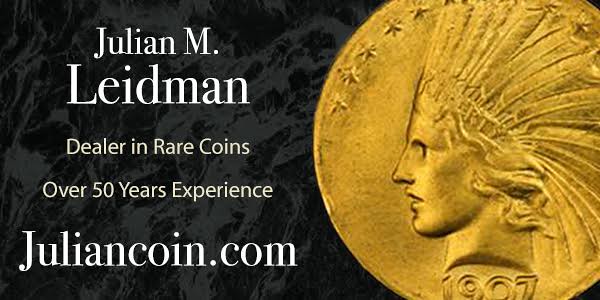
GEYSER SPEWS SHOWER OF OLD COINS
Last week Dave Lange sent me this article about old coins belched out (among other trash) by a geyser in Yellowstone. Cool. Thanks. -Editor

On Sept. 15, Yellowstone National Park's Ear Spring geyser erupted in its most violent display since 1957. For several minutes, sprays of steaming water leapt up to 30 feet (9 meters) in the air, chunks of rock and dirt spewed forth onto the ground and about 60 years of wishes were promptly reversed when the geyser gave up nearly 100 coins that had previously been tossed in.
Some coins were to be expected: Who among us hasn't flipped a good-luck penny into a thermal vent? But park officials were more surprised to find that decades of man-made garbage had also burst forth from Ear Spring — some of which dated back to the 1930s.
What have people been throwing into the geyser? Some of the historical detritus that Ear Spring coughed up includes a large chunk of cinderblock, a broken bottle, several metal warning signs, some old aluminum cans, plastic cups, cigarette butts, someone's rubber heel insert, a vintage pacifier from the 1930s and an 8-inch-long (20 centimeters) plastic drinking straw. (Editor's note: please do not try to drink a geyser.)
Whether these foreign objects were dropped into the geyser accidentally or chucked in on purpose makes no difference. Either way, park officials wrote, it's bad for the geyser.
To read the complete article, see:
A Geyser Erupted in Yellowstone and 80 Years of Human Trash Poured Out
(https://livescience.com/63768-yellowstone-geyser-garbage-eruption.html)
The Washington Post republished the story this week. -Editor
To read the complete article, see:
(https://www.washingtonpost.com/national/health-science/yellowstone-geysers-eruption-tosses-up-decades-of-human-trash-some-historic/2018/10/19/73eee8da-cc00-11e8-a360-85875bac0b1f_story.html?noredirect=on&utm_term=.a775aa814790)
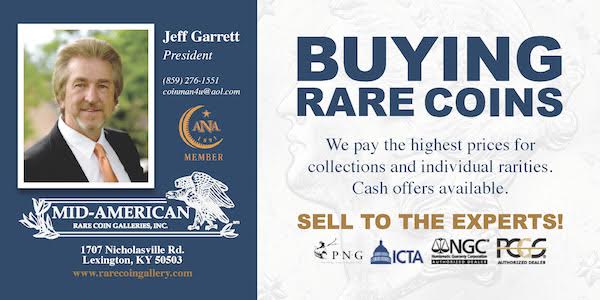
ROYAL CANADIAN MINT TEST TOKENS
While compiling this week's NUMISMATIC NUGGETS I also came across this Royal Canadian Mint item. -Editor
1996 Royal Canadian Mint $2 Test Token

1996 CAD 2.00 Test Token Original Package (ER)
Interesting transitional item. I wasn't aware of these. Nice idea of the RCM to market them. -Editor
To read the complete lot description, see:
1996 CAD 2.00 Test Token Original Package (ER)
(https://auction.auctionnetwork.ca/1996-CAD-2-00-Test-Token-Original-Package-ER_i31726991)
I looked for more information online and learned there's a long tradition of using these. Here's an excerpt from a page I found at the J& Coin & Jewellery Ltd. site. -Editor
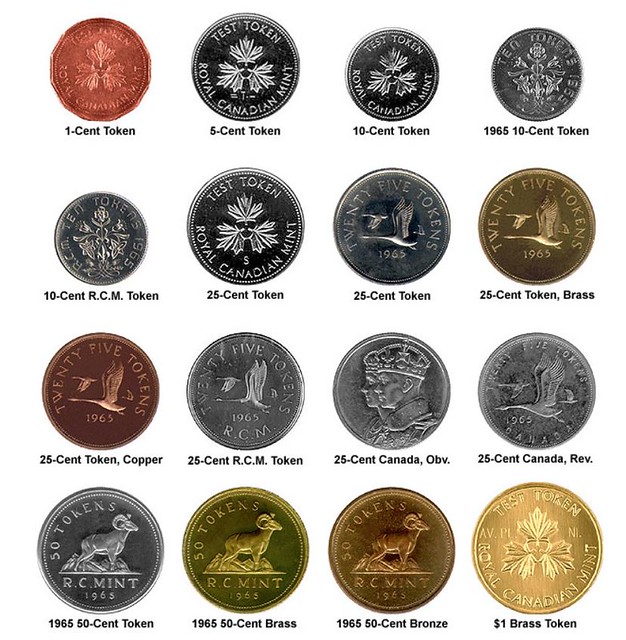
These are experimental test tokens. The purpose was to loan these tokens out to vending machine companies so they could calibrate their machinery in advance of a new coin being released. Therefore they are the same size and weight as the issued coin but usually with a markedly different design that identifies it as a token. Ideally, these tokens were supposed to be returned to the mint, and to this end a very high deposit is charged to the vending company to ensure their return but some simply never make it back home. These tokens are very rare, in fact few collectors ever see them.
This is an expanding series, meaning the mint continues to issue these tokens for machine calibrations as new coins are introduced. A recent advent is that the mint has sold its test tokens directly to the collecting public. The first and only issue of the tokens sold this way was the $2.00 test token, which sold out after only a few days of release and has since doubled in price. These tokens do have listings with catalogue numbers in the Charlton Standard Catalogue. No prices are shown because they trade so seldom, and who could price them anyways?
Experimental test tokens used to determine the best composition for longer life of dies. These are much rarer than the tokens given to the vending machine companies to calibrate their machines. Only very small numbers of these tokens exist. They were used to determine the best alloys to create the best possible image with the least amount of pressure. This would allow the dies to produce the maximum number of coins without requiring changing. Dies need to be changed when the engraving starts to be filled with metal from the planchets, or when cracks develop in the die.
To read the complete article, see:
Test Tokens (https://www.jandm.com/script/getitem.asp?CID=10&PID=10)

1912 SUFFRAGETTE HUNGER STRIKE MEDAL
Another 1912 Women's Suffragette Hunger Strike medal has been sold. See the earlier E-Sylum article (linked below) for another example. -Editor
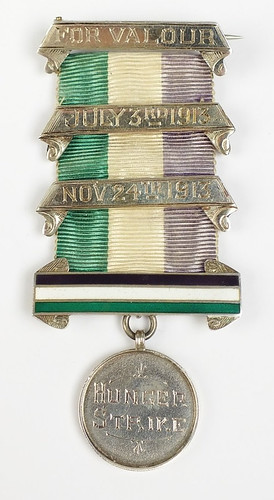 Clara Giveen is remembered for her part in the attack on Hurt Park grandstand in 1913 when she and the actress and suffragette, Kitty Marion, set fire to the racecourse
in Surrey.
Clara Giveen is remembered for her part in the attack on Hurt Park grandstand in 1913 when she and the actress and suffragette, Kitty Marion, set fire to the racecourse
in Surrey.
They were arrested the following morning and Giveen was sentenced to three years in prison and forcibly fed.
She was later released under the Cat and Mouse Act, and was given the Hunger Strike Suffragette Medal by the Women’s Social and Political Union (WSPU).
It was sold at Halls' October auction in Shrewsbury and caused a stir among bidders online and in the sale room.
Specialist valuer Derek Ainsworth said: "The interest in suffragette medals has been strong recently and we are delighted to have realised such a high price for this example.
The medal awarded to Giveen was engraved ‘Hunger Strike’ on the one side and had her name on the other.
The title ‘For Valour’ was engraved on a scrolled enamelled bar above two further enamelled bars carrying the dates July 3, 1913 and November 24, 1913.
However, most significant was the engraving on the reverse of the medal which read, ‘fed by force 1/3/12’.
The fight for women's voting rights was a noble one, but setting fires that could've killed people is nothing to be proud of. -Editor
To read the complete article, see:
Rare suffragette medal sells at Shrewsbury
auction (https://www.shropshirestar.com/news/local-hubs/shrewsbury/2018/10/27/rare-suffragette-medal-sells-at-shrewsbury-auction/)
To read the earlier E-Sylum article, see:
A SUFFRAGETTE SOCIETY MEDAL (http://www.coinbooks.org/esylum_v18n10a27.html)

AUSTRALIAN MILITARY DOG AWARDED DICKIN MEDAL
An Australian military dog has been awarded the Dickin Medal, issued to animals in recognition to their brave service. See the E-Sylum archives for more information on the medal and its unusual recipients. -Editor
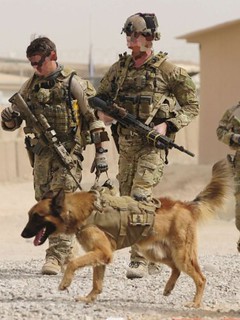

RIGHT: Dickin medal accepted on behalf of Kuga
When military dog Kuga and his special operations handler Sergeant J were choppered into Khaz Uruzgan in Afghanistan on a mission to locate a high-value Taliban target, they didn't know they were walking into an ambush.
"As Kuga was starting to swim across the river, that's when the first burst of automatic gunfire came in around him.
"I could see the rounds kicking up around him in the water."
Despite the gunfire, Kuga pushed on to the other side of the river, where he charged the shooter, and grabbed onto him.
"That forced that insurgent to target him as opposed to targeting us," Sergeant J said.
"The insurgent had an AK-47, and managed to get a shot onto Kuga, which forced him to let his grip go."
The insurgent escaped, but not before Kuga was shot five times and sustained shrapnel wounds to much of his body.
But he didn't give up.
Kuga spent the next nine months with vets in Afghanistan, Germany and Australia, who treated him and attempted to rehabilitate him.
But the stress the injuries and recovery process placed on him proved too much, and he died in July 2012.
On Friday Kuga became the first Australian dog to be awarded the Dickin Medal, which recognises the gallantry of animals during war service.
The only other Australian animals recognised by the medal are two carrier pigeons that served in World War II, the last of which was recognised in 1947.
Mary Reilly from the People's Dispensary for Sick Animals (PDSA), which awards the Dickin Medal, said it was given out very rarely for only the most conspicuous bravery among animals.
"Kuga's sacrifice was an ultimate sacrifice," she said.
Kuga's medal will be displayed at the Australian War Memorial in Canberra from next year.
"I'm pretty proud of what Kuga did that day," Sergeant J said.
To read the complete article, see:
'Victoria Cross for animals': Military dog Kuga posthumously awarded
Dickin Medal for bravery (https://www.abc.net.au/news/2018-10-26/dickin-medal-awarded-kuga-dog-canberra/10433054)

MSU MUSEUM COLLECTION REDISCOVERED
In a good news story, a coin and currency museum collection has been rediscovered at Mississippi State University. -Editor
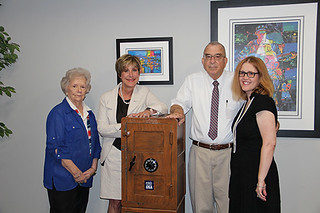 When Kathleen Thomas became the department head for Mississippi State’s Department of Finance and Economics this summer, she accepted the challenge of giving MSU
students everything they need to thrive in a 21st century economy. However, she quickly discovered a collection in a closed office safe that contained unique insight into the
Mississippi economy of the 19th and 20th centuries.
When Kathleen Thomas became the department head for Mississippi State’s Department of Finance and Economics this summer, she accepted the challenge of giving MSU
students everything they need to thrive in a 21st century economy. However, she quickly discovered a collection in a closed office safe that contained unique insight into the
Mississippi economy of the 19th and 20th centuries.
The unopened safe, it turns out, contained hundreds of pieces of antique money dating back to before the American Civil War. In the 1970s, the money was gathered by College of Business faculty, including George Verrall, to create a display on economic history in McCool Hall. After re-discovering the collection this summer, Thomas and the College of Business donated the old money to MSU Libraries. At Mitchell Memorial Library, the money will be stored and made available to those interested in using the collection for research.
“MSU Libraries is most fortunate to receive this excellent collection of coins and bills from this particular area of history,” Dean of Libraries Frances Coleman said. “Each item appears to be representative of some specific event of that particular time. Students, researchers and historians will greatly benefit from this gift provided by the College of Business and Dr. Verrall.”
MSU College of Business Dean Sharon Oswald said the antique money helps tell the story of Mississippi’s economic history.
“During his decades of service at MSU, Dr. Verrall left a substantial legacy in the College of Business and the university, including this significant collection,” Oswald said. “I am glad that this collection will be in the excellent care of MSU Libraries and that others will be able to learn from this tremendous resource.”
Also a university administrator, Verrall worked to establish the money collection in the mid-to-late 1970s. By late 1978, Verrall and former dean Gaines M. Rogers had established the “Currency and Coin Museum” in McCool Hall.
“It became obvious to me that Mississippi had a rich history in money,” Verrall said. “In 1850, Mississippi’s economy was roaring, but it was limited by the amount of gold, silver and copper coins that were available. Banks and railroads began to issue their own money. I figured somebody ought to assemble a representation of early paper money in Mississippi. I wanted to gather that history, if we could.”
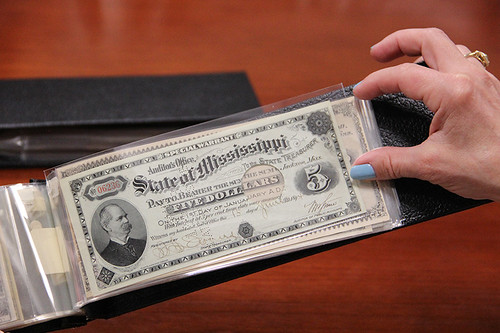
Through donations and acquisitions, the College of Business was able to acquire Mississippi-based currency from before, during and after the Civil War, as well as from the Great Depression. The collection contains money issued by private companies, money issued by the state, and money for specific cities, which was issued during the Depression.
“After I retired and others retired, they just left the safe in the department head’s office,” Verrall said. “Until Kathleen moved in and asked, ‘What’s in the safe?’ Now is the right time to transfer it to the library, since the library is now the holder of many objects of significant value. They’ll know what to do with it.”
Sounds like a great litle collection. Glad it was rediscovered. Thanks to the Society of Paper Money Collectors October 23, 2018 News & Notes newsletter for bringing this article to my attention. -Editor
To read the complete article, see:
Old money finds new home in MSU Libraries after
being discovered in safe (https://www.msstate.edu/newsroom/article/2018/10/old-money-finds-new-home-msu-libraries-after-being-discovered-safe/)
THE BOOK BAZARRE
NEW ZEALAND VEGANS PROTEST POLYMER BANKNOTES
The traces of tallow on polymer banknotes has raised a fuss in new Zealand now that the notes are being introduced there. -Editor
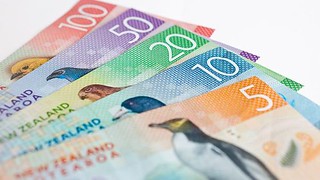 Vegans are outraged after learning New Zealand banknotes uses tallow — rendered animal fat from sheep, pigs and cows — as a "slip agent" to prevent friction
and static.
Vegans are outraged after learning New Zealand banknotes uses tallow — rendered animal fat from sheep, pigs and cows — as a "slip agent" to prevent friction
and static.
The secret ingredient of tallow has been used for more than a decade and only became public when Britain adopted the same technology to produce its £5 note last year, resulting in a UK protest movement.
NZ notes are made up with 1 per cent animal fat.
The news in the UK and Australia has caused a great deal of heated discussion online.
An online video recently posted to Facebook by social commentators Project Nightfall in Australia reveals tallow is used in Australian currency, as well as in bank notes from Canada, Malaysia, Singapore and other countries — a total of 23, including New Zealand.
"This video is not friendly to vegans, Muslims, Hindus or Jews" warns the video.
The video has attracted over 630,000 views, and provoked nearly 5000 shares, and over 700 comments.
Some Facebook users were horrified by the news.
Tallow is already used in a number of household items such as soap, candles, plastic bags, moisturisers, and even some fabric softeners. It's also found in some aeroplane fuel and even in mobile phones. Animal byproducts are also used in many clothing and cosmetics.
I don't know where the "1 per cent animal fat" came from. Figures on similar polymer notes from the Bank of England indicate only trace amount on the order of 5 parts per million, or 1/2000th percent.
Other articles online say the "secret ingredient" "shocked netizens". This aspect of polymer banknotes has been public for some time and as many commentators have noted, it's a big fuss over all-but-nothing. Some people aren't happy without something to get outraged about. -Editor
To read the complete article, see:
Vegans outraged after animal fat used to make NZ banknotes
(https://www.nzherald.co.nz/lifestyle/news/article.cfm?c_id=6&objectid=12149227)
WHIO: THE BLUE DUCK ON NEW ZEALND BANKNOTES
In the bluebird-gets-bluer department, here's an outrage-free article on New Zealand banknotes. Thanks to the Society of Paper Money Collectors October 23, 2018 News & Notes newsletter for bringing this article to my attention. -Editor
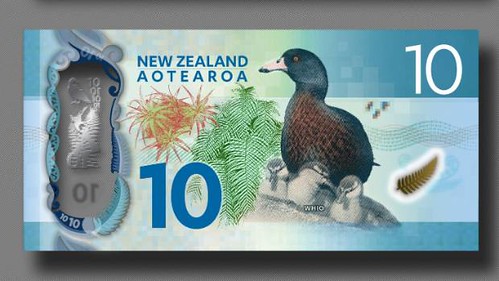
People just think they are another duck until they see one, says Tracey Hickman, Genesis Energy's executive general manager for generation and wholesale.
She's talking about the blue duck, now more commonly referred to as the whio, which makes its home on many of the rivers on which power generator Genesis has power stations.
Hickman saw her first whio 15 years ago, and was immediately struck by the realisation they were not just another duck.
"They were remarkable in terms of their colour, and their ability to sit still on fast-flowing water."
Calling whio blue does them a disservice, as did their drab image on the old $10 banknote.
But in 2015, the new "brighter banknotes" put a much truer image of the whio into the nation's wallets and purses capturing the subtle colours of their plumage running through blue, grey and russet.

In the 15 years Forest and Bird has been running its Bird of the Year competition, Kea, kokako (on the $50 banknote), Bar-tailed Godwit, Fairy Tern, Mohua (on the $100 note), New Zealand Falcon (on the $20), kakariki, Kiwi, Kakapo, Grey Warbler, Fantail and Tui carried off the honour. Even the humble Pukeko, which introduced itself from Australia, was named bird of the year in 2011.
But the whio has never won enough public votes to get to the top of the list. This year, the public ranked it 8th.
To read the complete article, see:
Double the duck: Securing the future of the duck on the $10
note (https://www.stuff.co.nz/business/107994986/double-the-duck-securing-the-future-of-the-duck-on-the-10-note)
LOOSE CHANGE: OCTOBER 28, 2018
Here are some additional items I came across in the media this week that may be of interest. -Editor
Dave Bowers, Postcards and Numismatics
A Coin Update article published October 25, 2018 profiles author Dave Bowers and his upcoming book Guide Book of American Postcards. -Editor
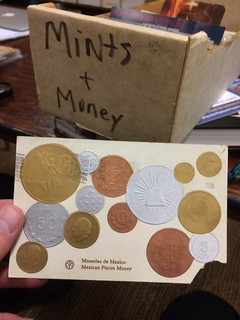 What do numismatics (the study of currency) and deltiology (the study of postcards) have in common? Much more than you might think. Both studies make extremely popular
collectible hobbies in the forms of coin collecting and postcard collecting, respectively, and both are a method of preserving and studying history.
What do numismatics (the study of currency) and deltiology (the study of postcards) have in common? Much more than you might think. Both studies make extremely popular
collectible hobbies in the forms of coin collecting and postcard collecting, respectively, and both are a method of preserving and studying history.
To read the complete article, see:
The crossroads of numismatics and deltiology: Mary L. Martin
and Q. David Bowers (http://news.coinupdate.com/the-crossroads-of-numismatics-and-deltiology-mary-l-martin-and-q-david-bowers/)
Coin Press No. 1 Strikes Again
The old Carson City Mint Coin Press No. 1 was pressed into service to strike commemorative medals this week. -Editor
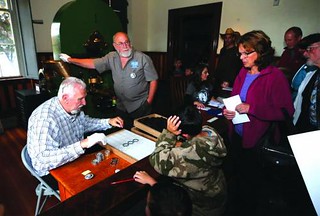 Nevada Day revelers can own a piece of the state’s history — and also watch it be made — as part of a special run of the coin press at he Nevada State Museum in Carson
City.
Nevada Day revelers can own a piece of the state’s history — and also watch it be made — as part of a special run of the coin press at he Nevada State Museum in Carson
City.
In honor of the opening of the new Battle Born Hall inside the state Capitol, the coin press will be minting its newest medallion featuring the Battle Born logo 9 a.m. to 3 p.m. Saturday, Oct. 27. Admission to the museum will also be free that day.
Those interested can watch the historic press operate, even buy a medallion of their own.
Enthusiasts can purchase blank planchets, made from .999 fine silver, from the gift shop and have the half-dollar-sized medallion minted on Press No. 1.
To read the complete article, see:
Museum coin press to hold special minting during Nevada Day
(http://www.carsonnow.org/story/10/23/2018/museum-coin-press-hold-special-minting-during-nevada-day)
Lyall Collection Prices Realized
This World Coin News article discusses prices realized at the recent Dix Noonan Webb sale of the Lyall Collection. -Editor
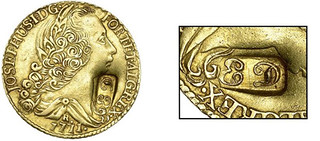 By any standard, the Dix Noonan Webb sale of the Lyall Collection of cut and countermarked coins on Sept. 25 was an outstanding success.
By any standard, the Dix Noonan Webb sale of the Lyall Collection of cut and countermarked coins on Sept. 25 was an outstanding success.
Too often in recent years the sales of specialized collections have failed to live up to their pre-sale hype. Not so the Lyall. It proved to be a classic white glove event.
Bidding was so competitive that it took well over twice the anticipated time for the 328 lots to cross the block. Pre-sale estimates were left in the dust as bidders from around the globe competed for rarities unseen for decades. At sale’s end, the total realized was $798,671 [£610,338] on estimates of just over $250,000.
To read the complete article, see:
Lyall Collection realizes $800,000
(http://www.numismaticnews.net/article/lyall-collection-realizes-800000)
eBay "Safe full of coins"
Bob Merchant raised his eyebrow over this eBay lot listing about a pile of high-grade coins "Found in safe of 200 year old store during demolition!" -Editor
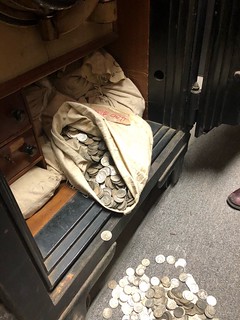
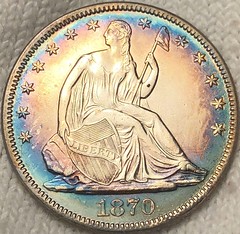
1870 Seated Liberty Half Dollar. Uncirculated per expert
During the demolition of a 200+ year old pottery store an enormous safe was found (See photos). Most of the contents were junk, but the shop owner was an avid coin collector and hoarded away some of the best pieces that came into the shop, just as his father had done. Many of the coins are dusty and dirty, but I read online not to touch the coins in any way. Therefore, they will be listed exactly as found. Some of the coins were encased years ago, many not. A long-time collector volunteered his time to see that all coins are 100% Authentic guaranteed.
Bob adds:
Check out the other coins he has for sale from the same find. There are some whoppers.
To read the complete lot listing, see:
1870 Seated Liberty Silver Half Dollar, Beautiful
Uncirculated Coin. No Reserve (https://www.ebay.com/itm/1870-Seated-Liberty-Silver-Half-Dollar-Beautiful-Uncirculated-Coin-No-Reserve/292782286009)
BIKINI COINGIRL
Well, you can find just about anything on YouTube. How about "Bikini Coingirl searches for awesome wheaties errors"? Streamed live on November 11, 2017, the channel had 675 subscribers and 647 views for the video as of Saturday afternoon. -Editor
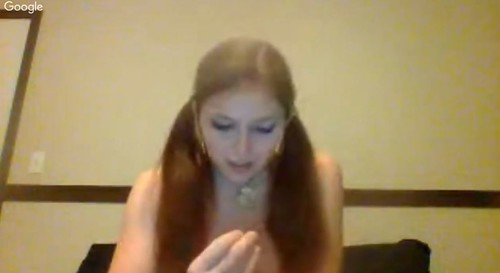
To watch the complete video, see:
Bikini Coingirl searches for awesome wheaties errors (https://www.youtube.com/watch?v=Yi76bPW3PQw)

